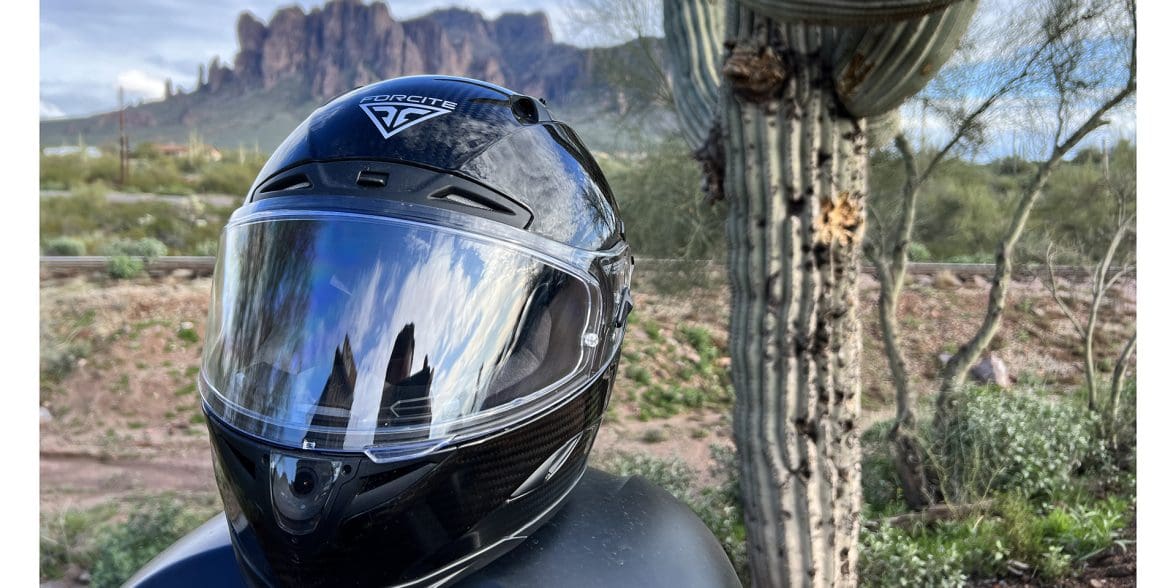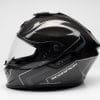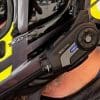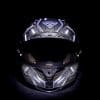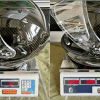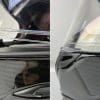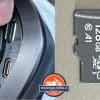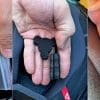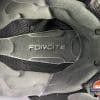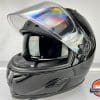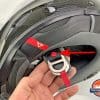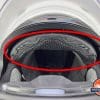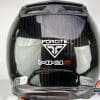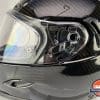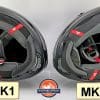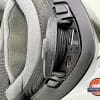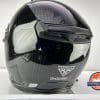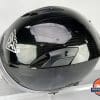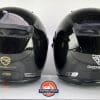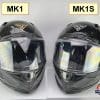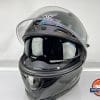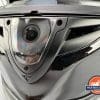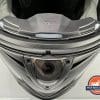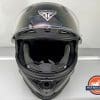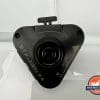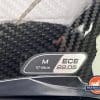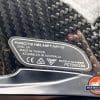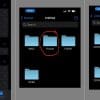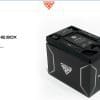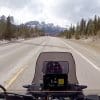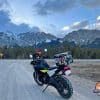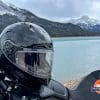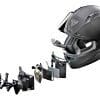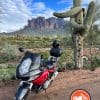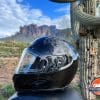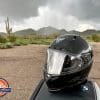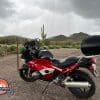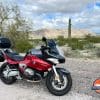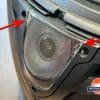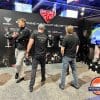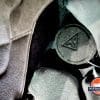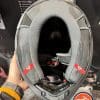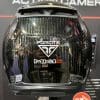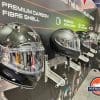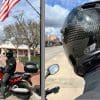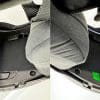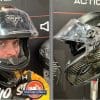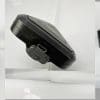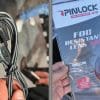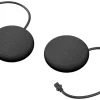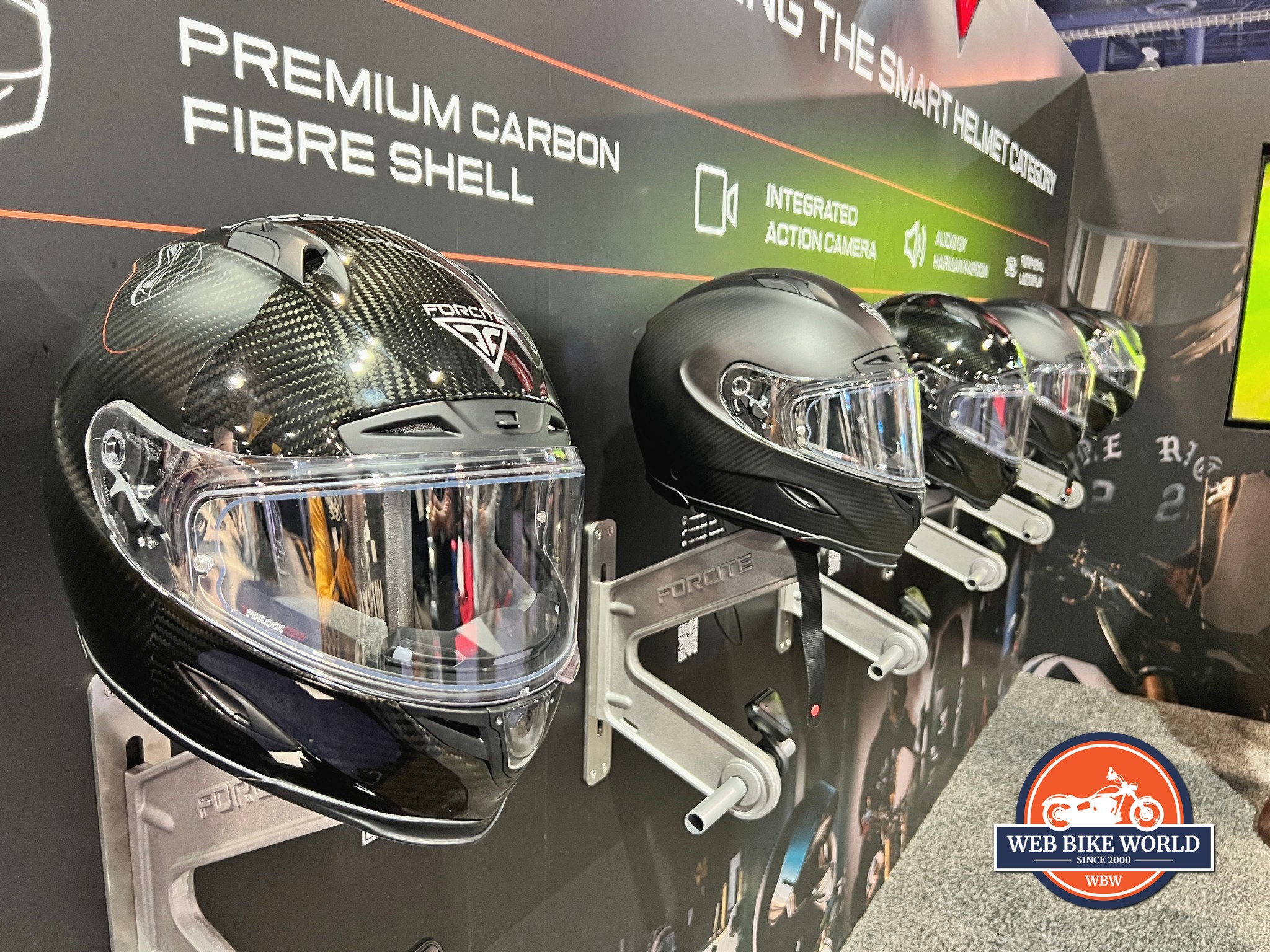
The Best –The Only– Smart Helmet On the Market
In 2019 I met a group of 5 impressive Australians in Milan, Italy at the EICMA motorcycle show. They were showcasing their revolutionary smart helmet called the Forcite MK1.
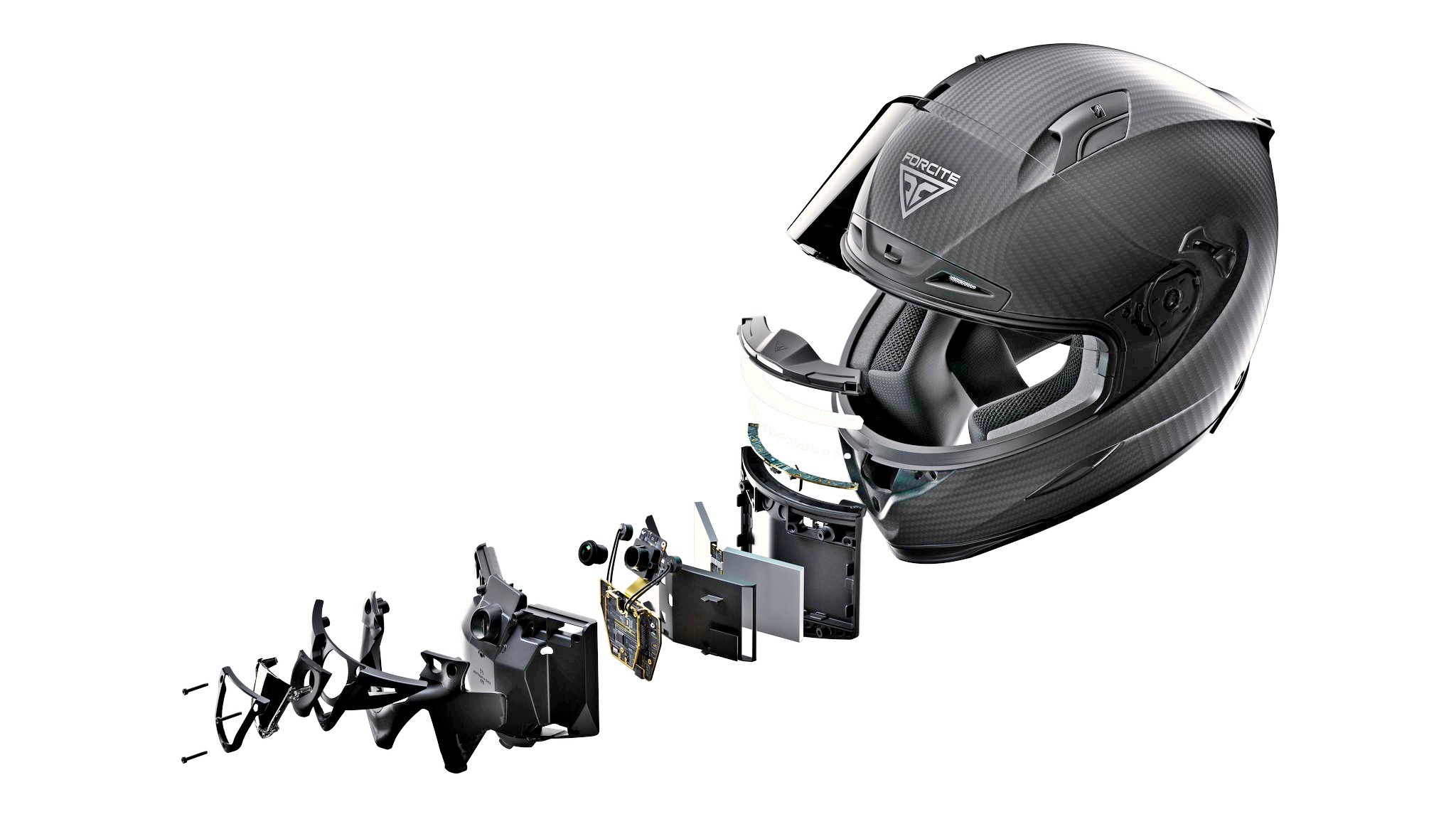
The MK1 had a clever LED heads-up display built into the chin bar breath deflector which illuminated to provide visual cues for navigational instructions along with safety-related warnings. A system called RAYDAR relayed information detected in a Forcite smartphone app to the wearer about police speed traps, inclement weather, road obstacles, and construction work.
To say I was blown away by the prospect of all this being coupled with a 1080p integrated camera would be an understatement. Here it was! Finally, a helmet for tech geeks like me!
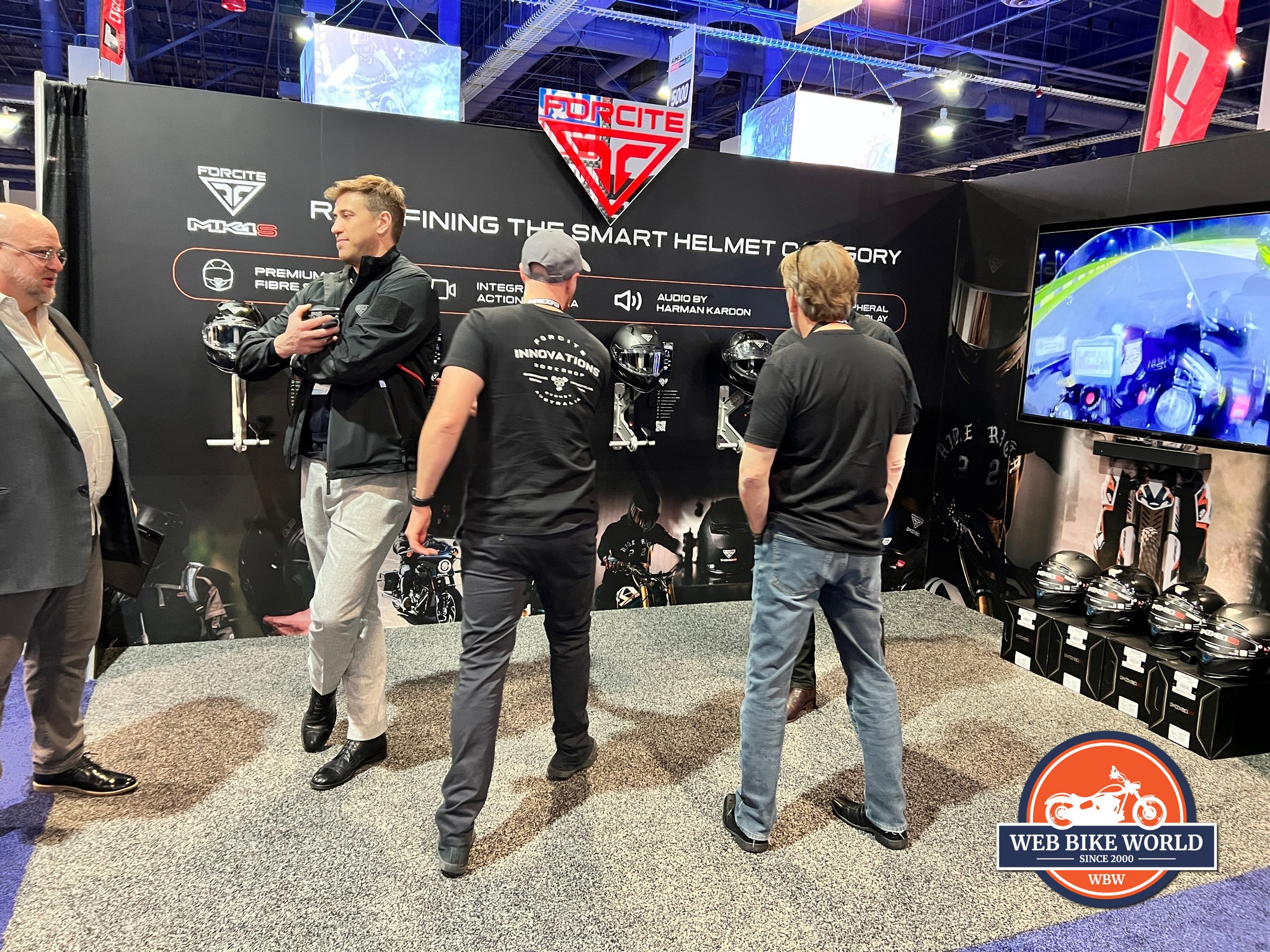
Have a look at the video below that I recorded at that show of Alfred, Jay, Tom, Dylan, and Sebastien showing off their prototype MK1 helmet. Jump to the 2:12 mark to see the LED HUD in action.
Did I mention that at the time none of the team from Forcite were older than 32?
Finally, I Got One To Review
The Forcite MK1 was initially only sold in Australia where 1000 of them were field tested by riders down under with the goal of working out all the bugs before Forcite went worldwide with it.
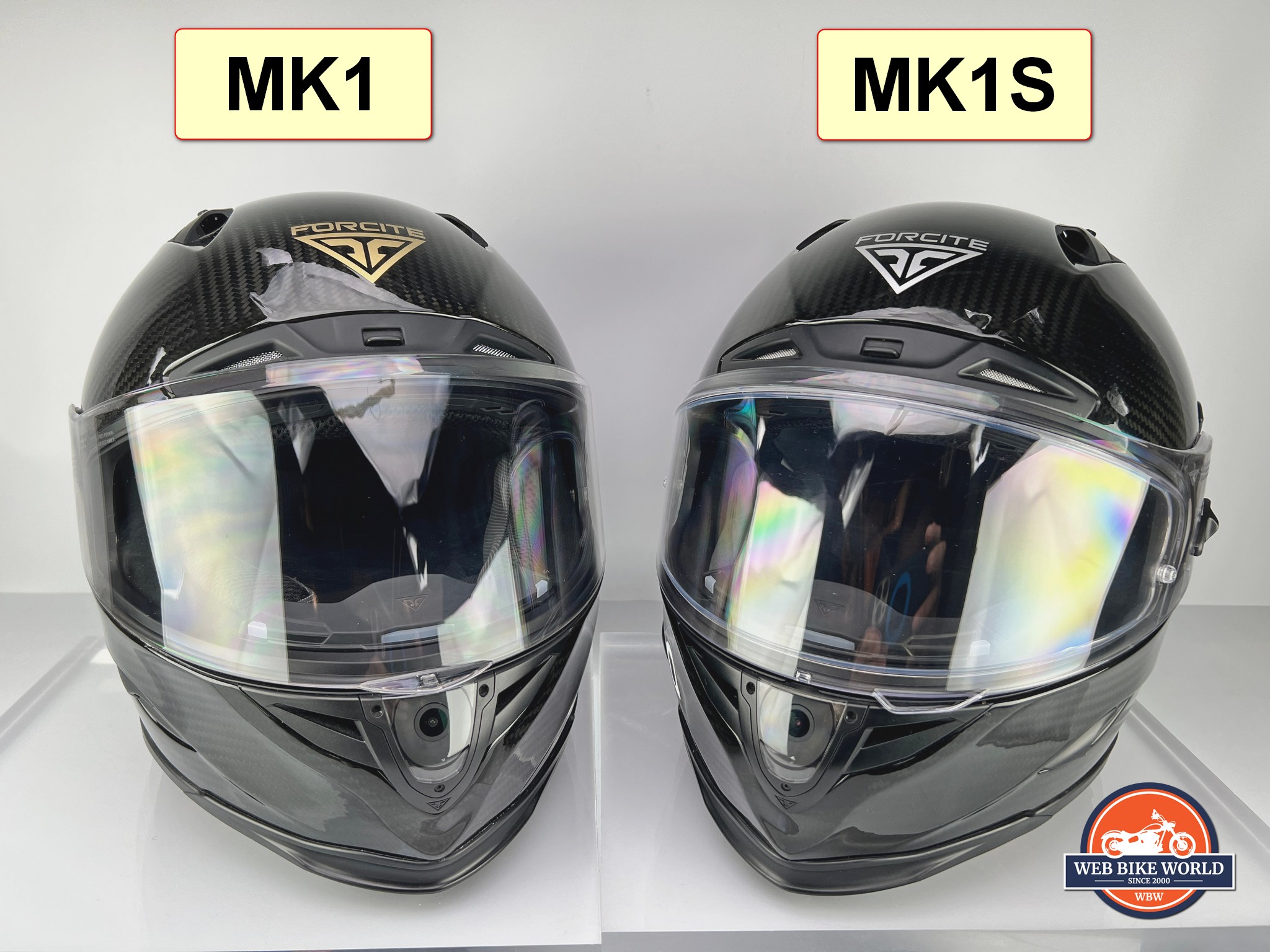
Forcite allowed me to purchase one of the first 1000 Forcite “Founders Edition” MK1 helmets to test here in Canada, but unfortunately, that Medium helmet which should have fit me was in fact too small. The MK1 remains in my helmet collection today as a treasured keepsake but it wasn’t until 2023 that I got my hands on the noticeably improved MK1S that is featured in this review.
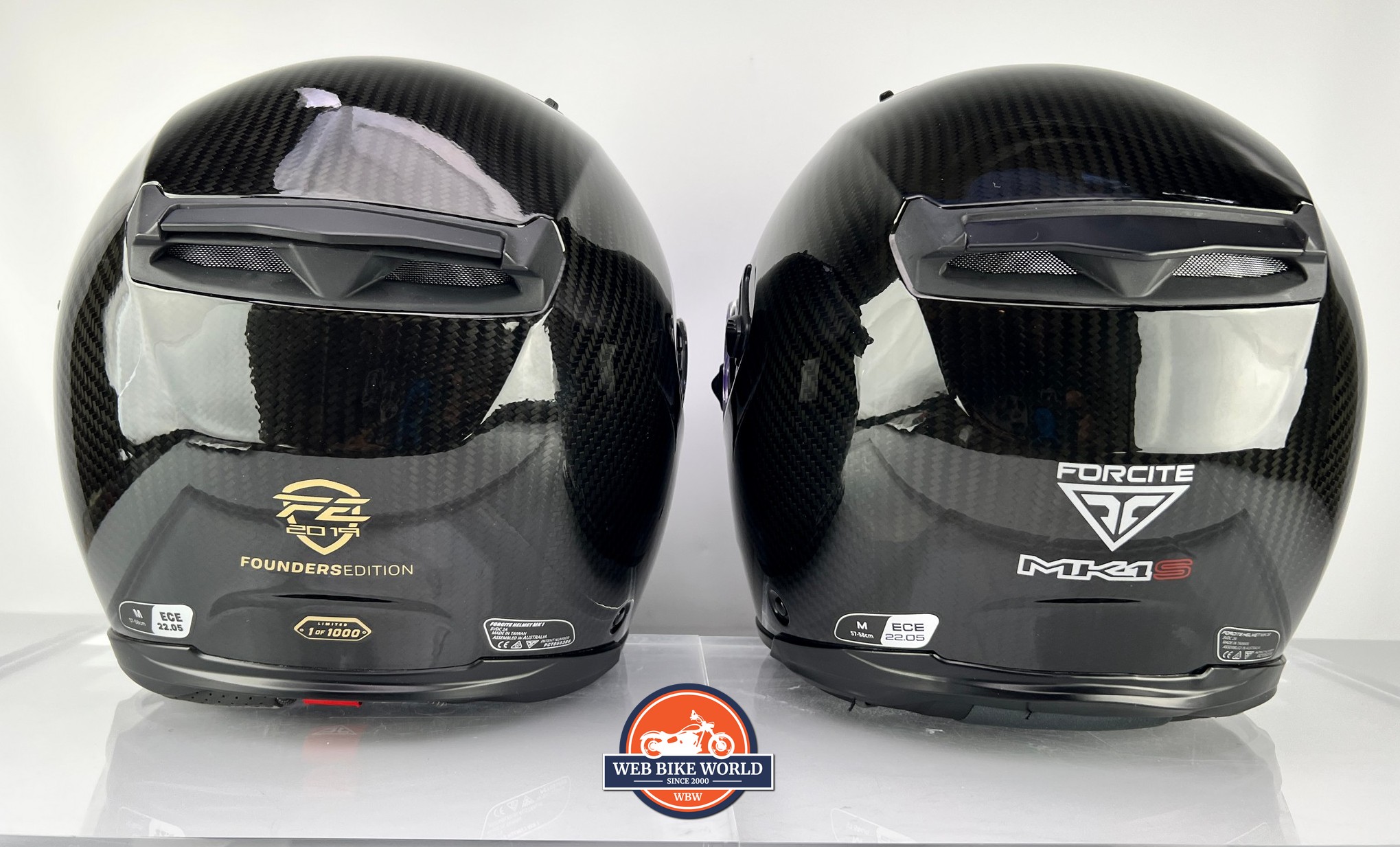
Cheers, Mate!
The team at Forcite provided me with the MK1S at no charge for the purposes of this long overdue review, and I thank them for that.
What’s in the MK1S box?
There’s good value in the box as you’ll see in the photo below, but most interesting to me is the certificate of authenticity from the Co-Founders Jay and Alfred. I don’t recall seeing anything like that before in a helmet box.
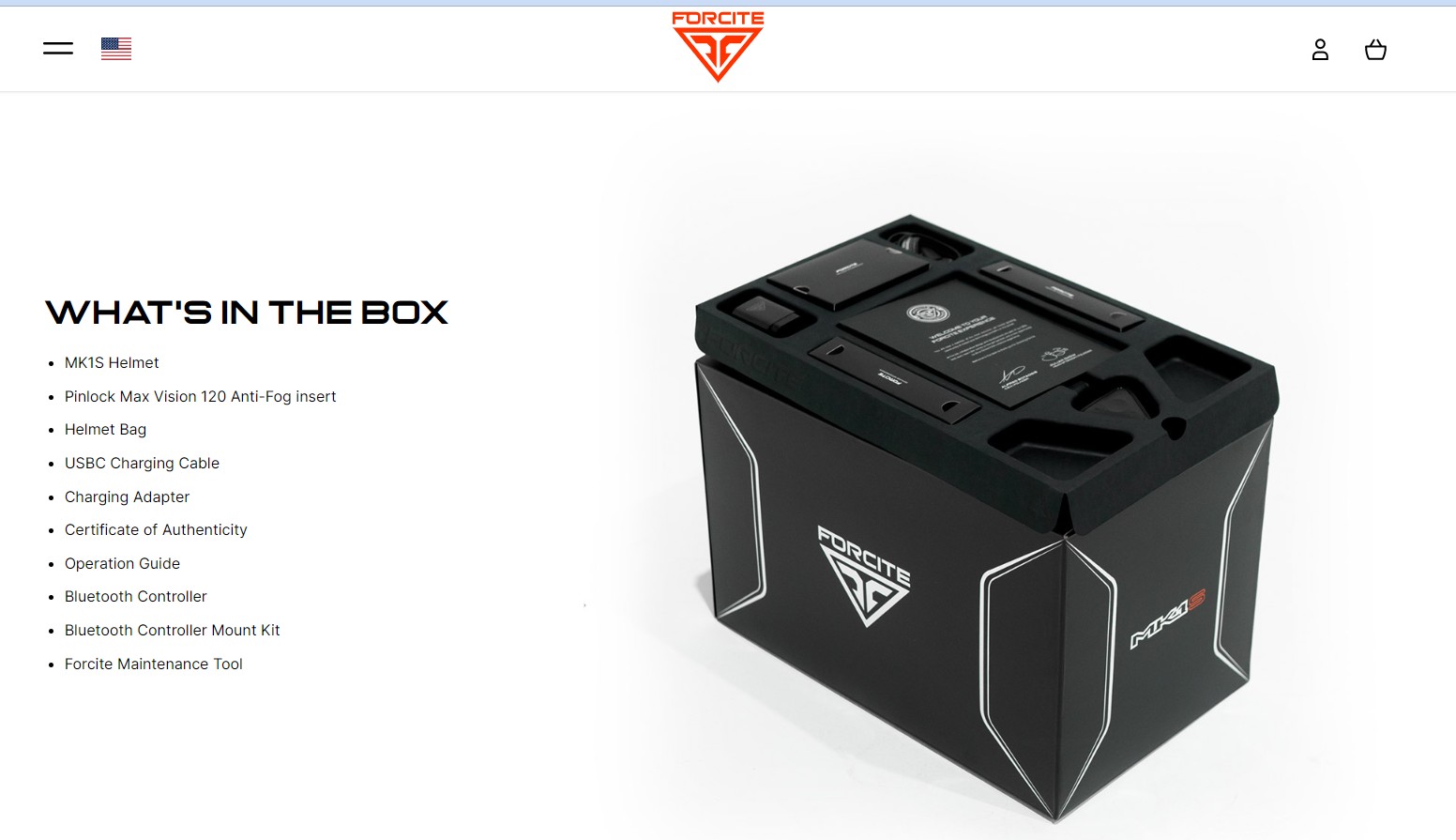
Forcite MK1S Helmet Design, Fitment, & Shape
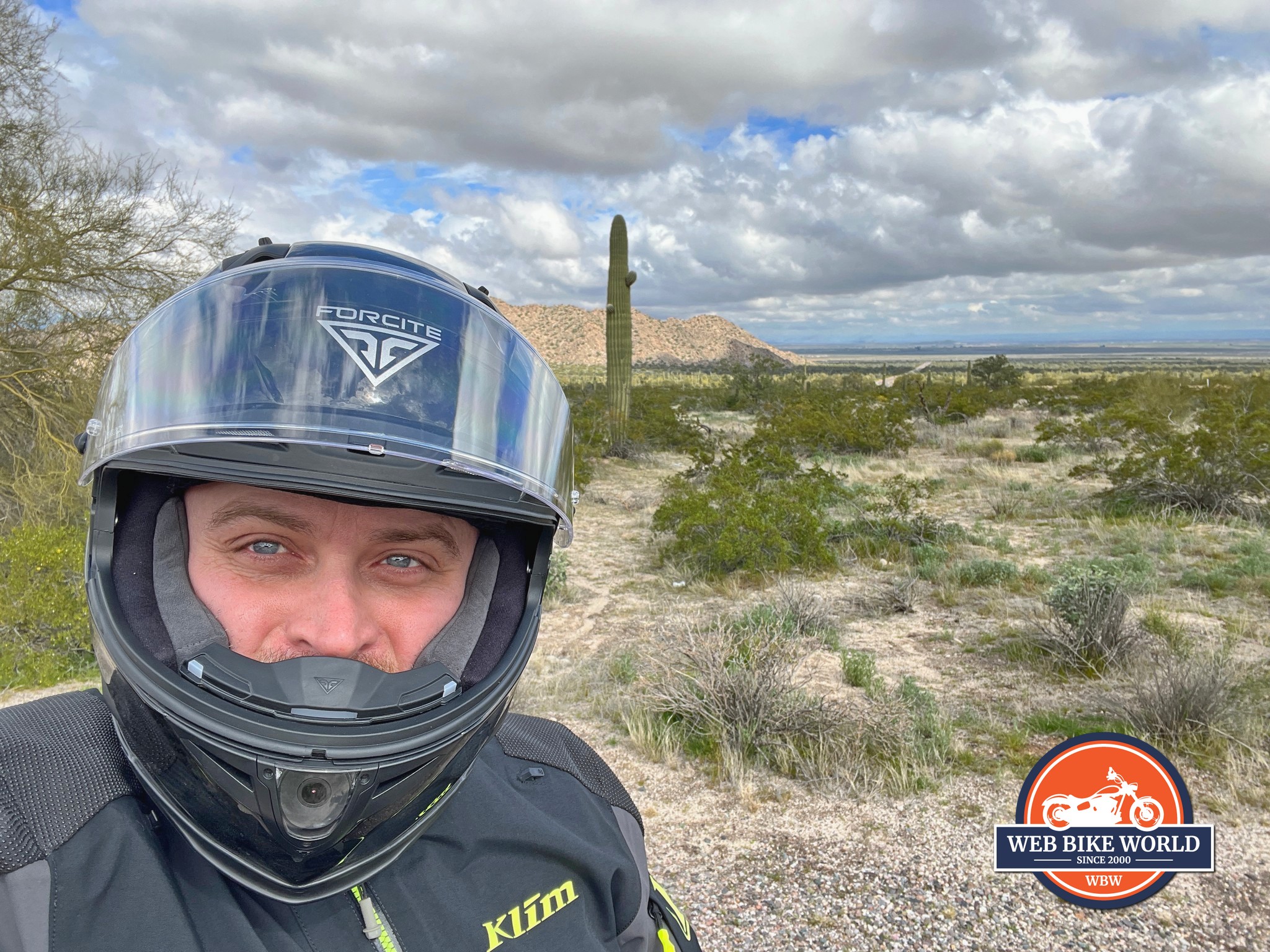
Design
Forcite was inspired to build the MK1S as a track-worthy full-face helmet and the streamlined shell tapering back to a prominent fin/vent shows it
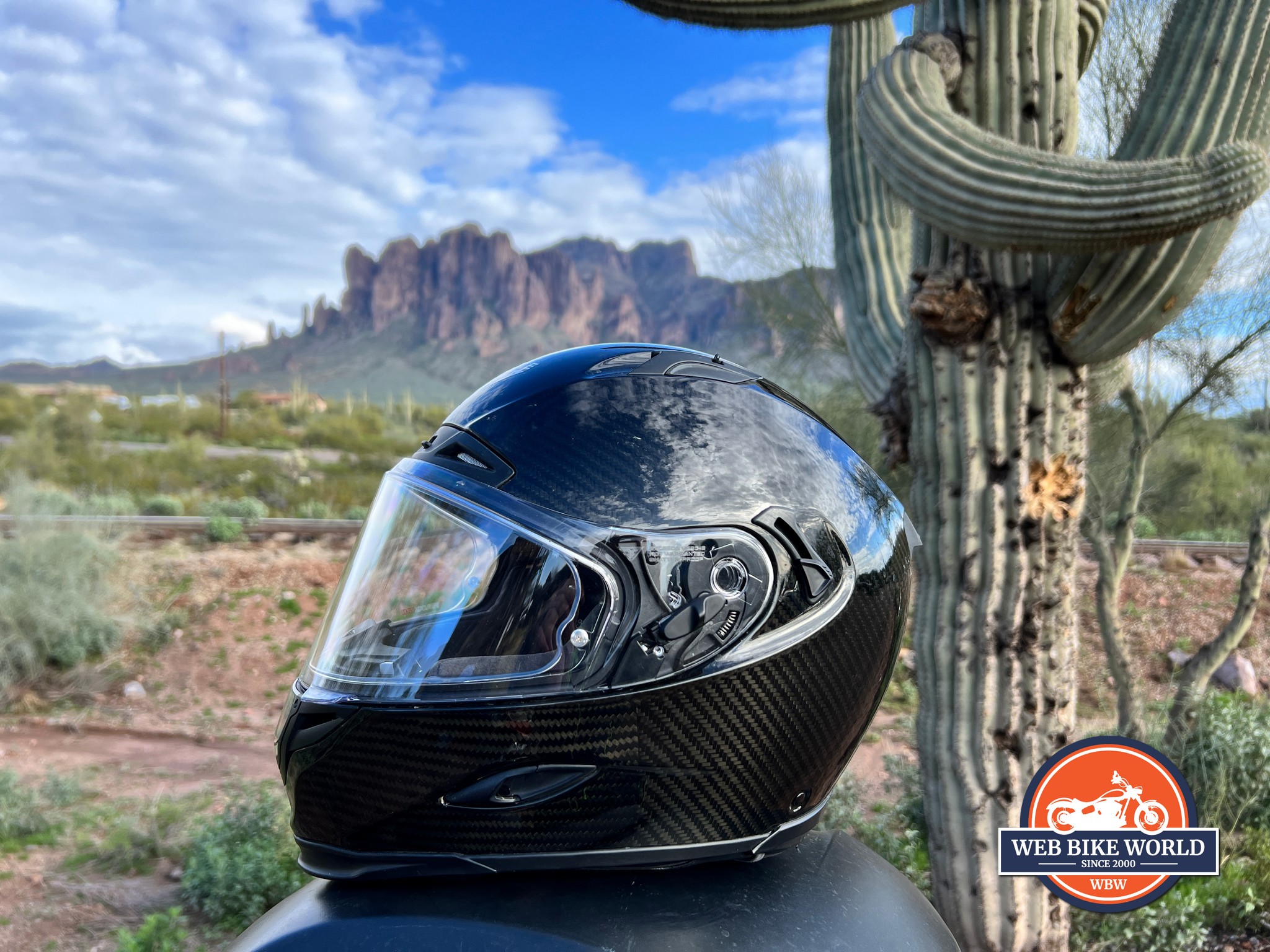
It also features double D-ring loops on the chinstrap and visor locking tabs on either side to comply with the requirements of many racing groups.
DOT Only?
The ECE 22.05-approved MK1S has been worn by racers in Australia for a while now. They’ve provided some awesome first-person footage that racers on this side of the pond will undoubtedly want to emulate.
The problem with that is the MK1S here will only carry DOT certification and many tracks in North America require Snell, ECE, JIS, BSA, or FIM-certified helmets. For example, the EMRA which runs events in my neck of the woods specifically requires anything other than just a DOT helmet.
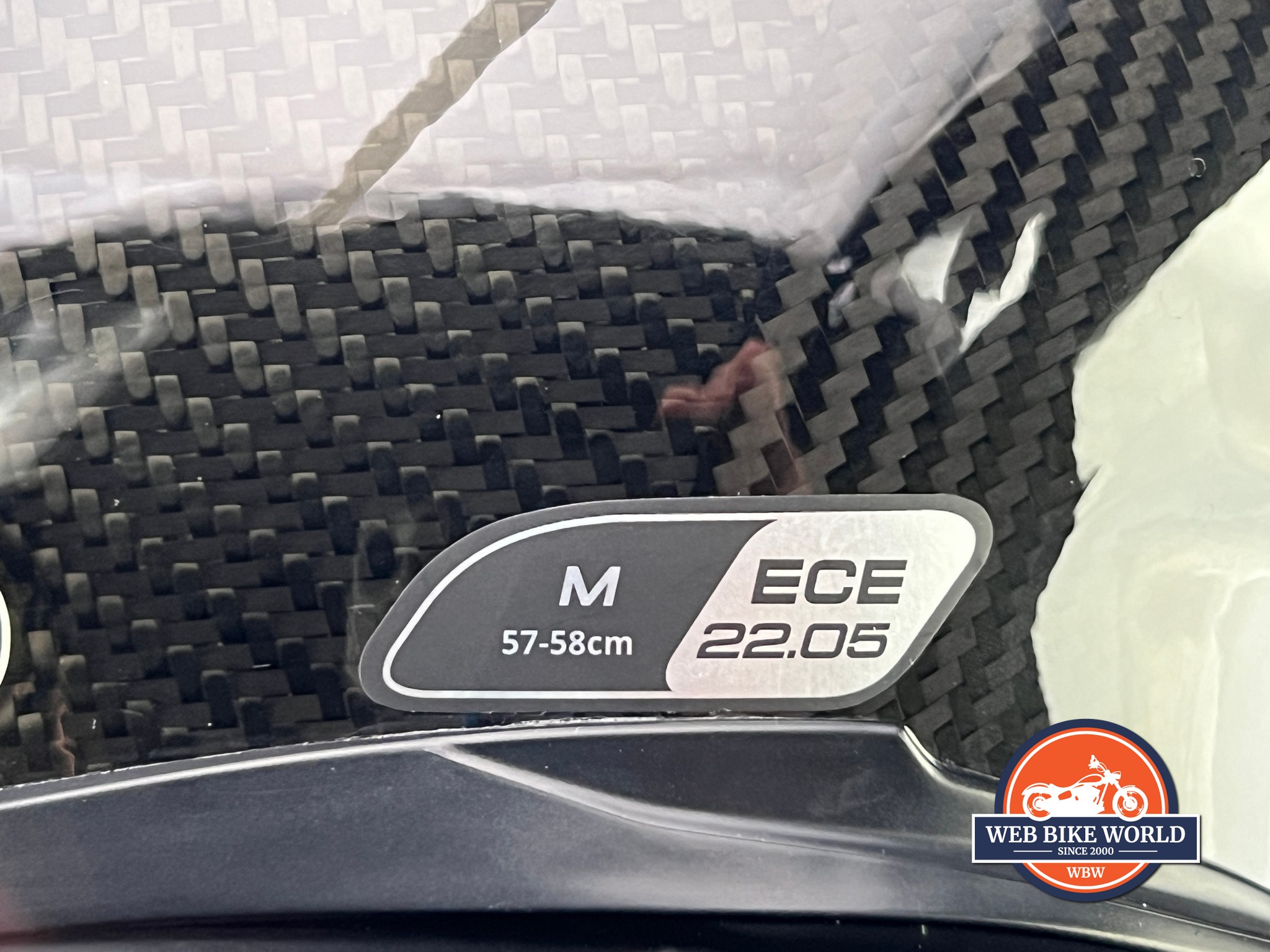
This might put a serious wrinkle in the plans of owners here to use their Forcite on track days even though the helmet can pass ECE 22.05. Hopefully, an exception will be made to allow it or Forcite will leave the ECE decals on the MK1S.
Fitment
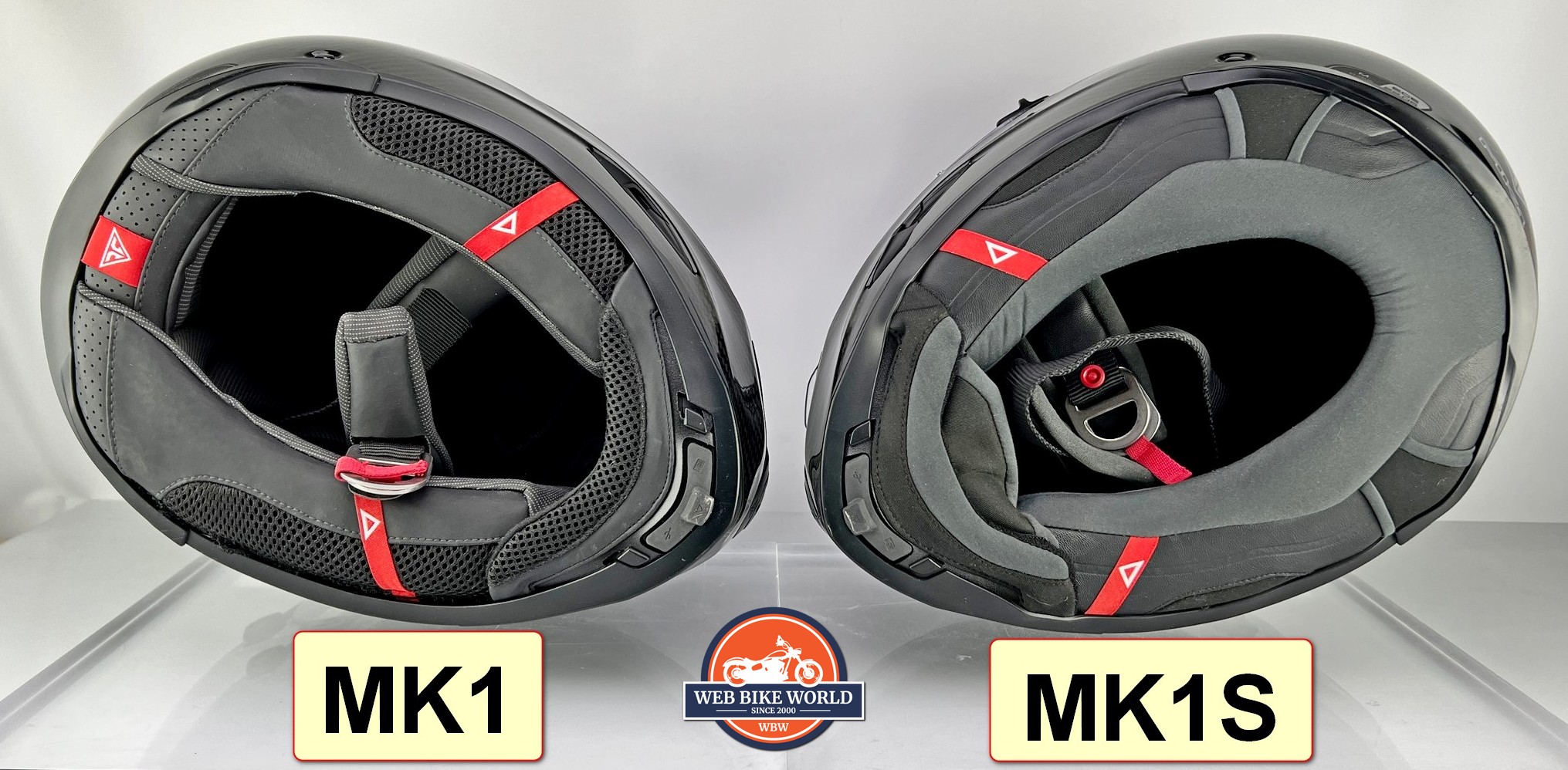
The original MK1 fit small on everyone who tried wearing it, including me. This created an annoying complication for the fledgling company and so Forcite revamped the 3 shell sizes and padding used for the MK1S to ensure it would fit true to size.
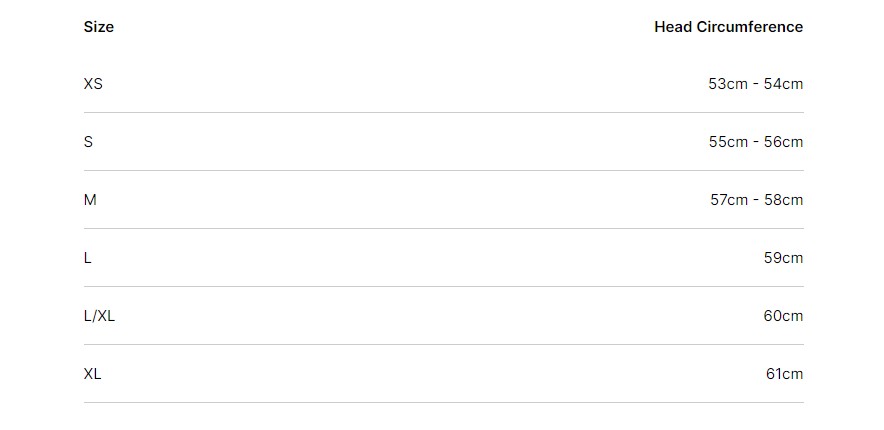
They also offer a one-time exchange free of charge in case you measure wrong or just have an oddly shaped coconut to account for.
I can confirm that they sorted this problem because the Medium MK1S fits my 23” or 58.42cm head very snugly out of the box as it should since that size technically only reaches up to 58cm. After riding 600 miles in it I found the comfort liner padding relaxed just enough to make it a near-perfect fit without pressure points… except in one spot on my forehead that I’ll talk about later.
It’s An Ear Folder
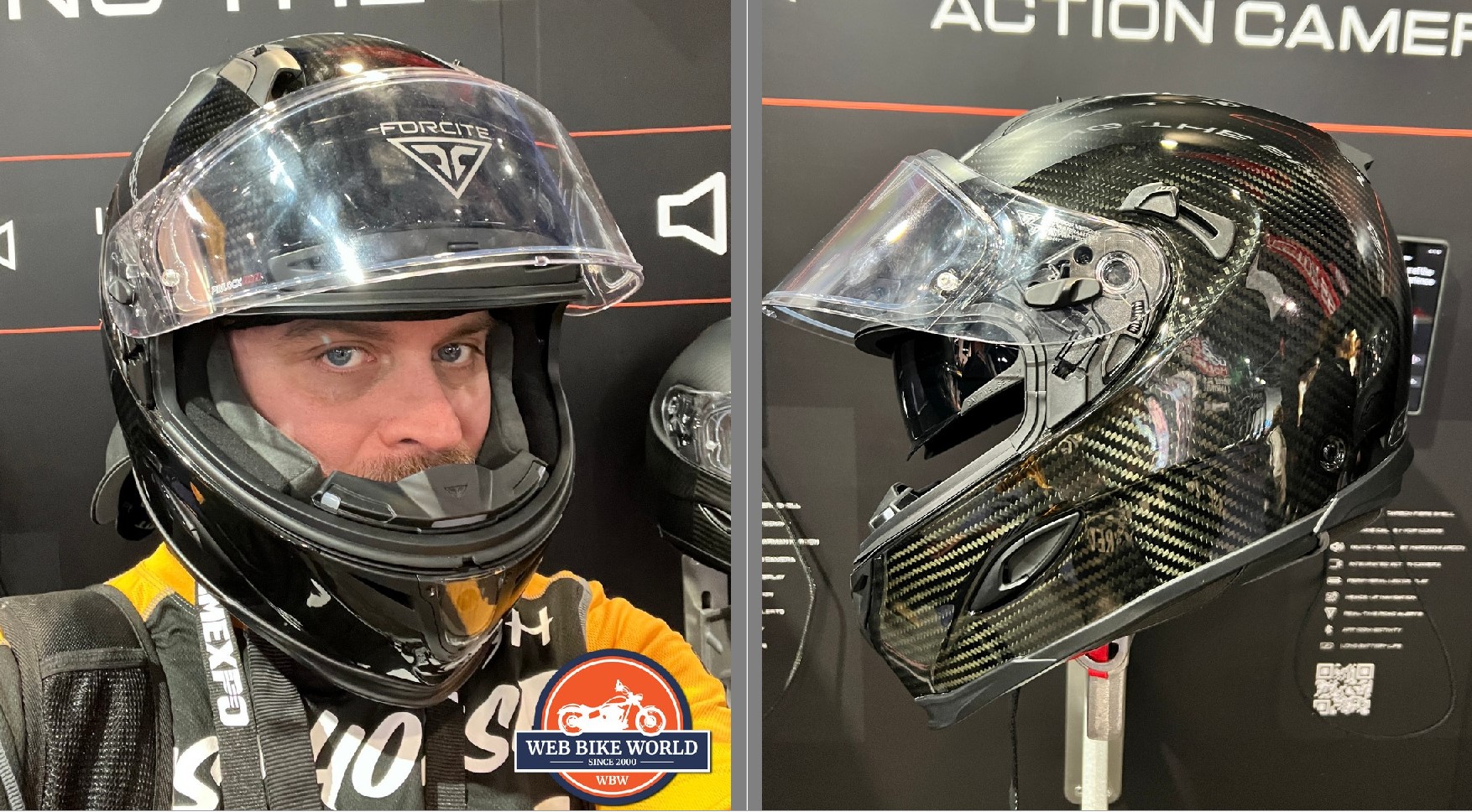
Like many helmets I’ve tested the MK1S neckroll folds over my ears whenever I pull it on and I have to fiddle with the helmet and poke around with my fingers to get things settled as nature intended. Not a new thing for a wide-faced, round oval head like mine.
Head Shape
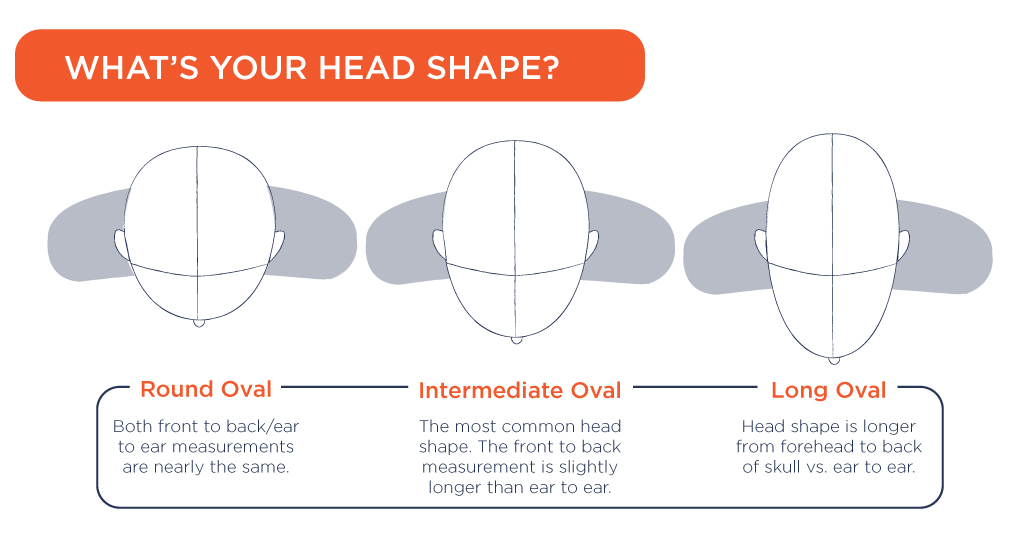
Intermediate oval is the most common head shape in the North American market. Hopefully, this won’t be an issue for Forcite as they enter the American market with the MK1S in mid-2023.
The Safety Factor
The MK1S shell is crafted from T400 carbon fiber meaning it’s strong and lightweight.
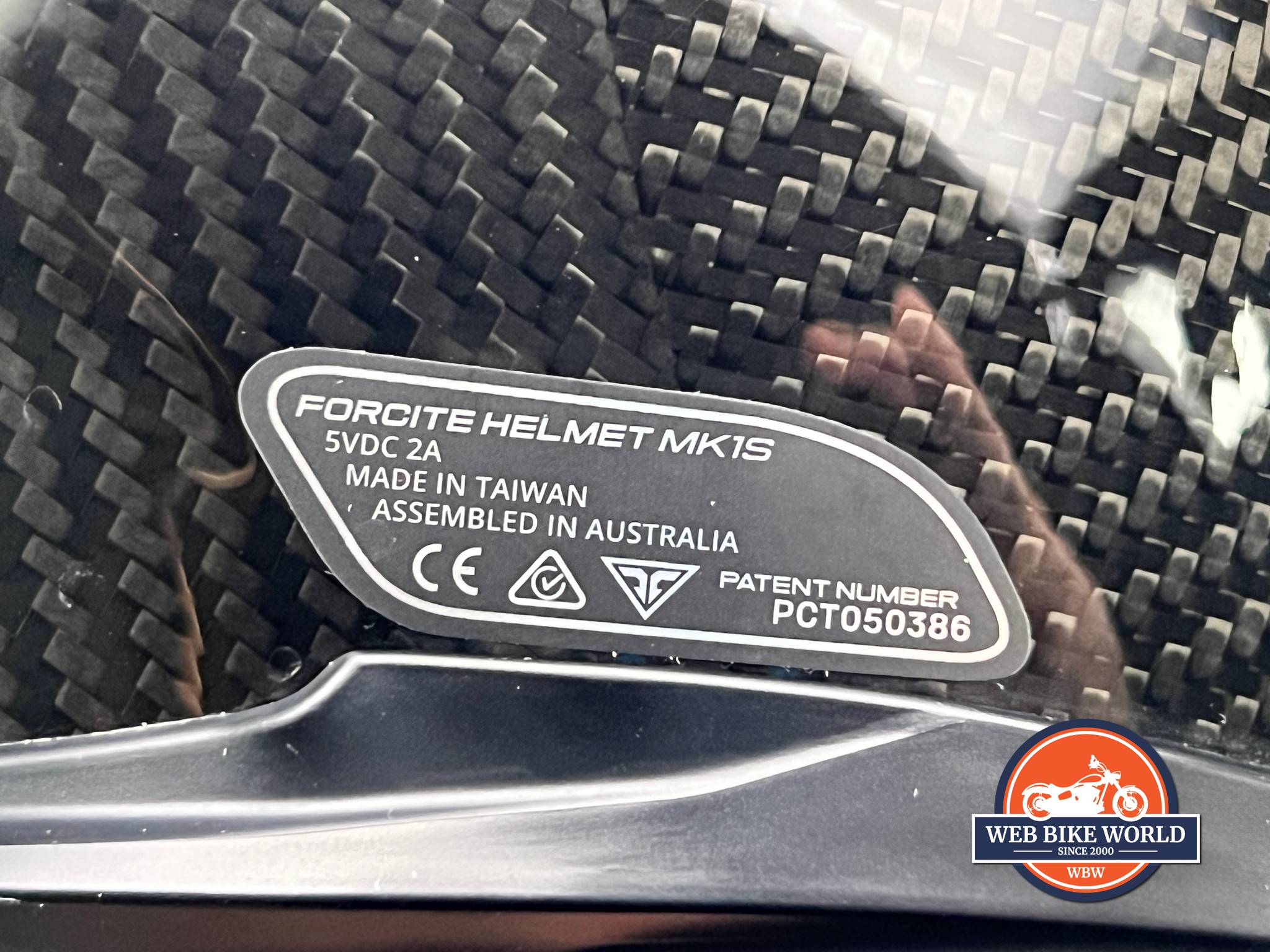
The added surprise bonus in the area of safety comes from the location of the electronics module housed in the chin bar. Forcite claims that installing the module in the chin bar reinforces the structure and provides something of a shock absorber in an impact. That sounds plausible but hasn’t been confirmed independently to my knowledge.
SHARP Testing
Unfortunately, SHARP hasn’t yet tested the MK1S so I can’t provide an independent and scientific assessment of the helmet’s crashworthiness.
On the other hand, several people have already crashed while wearing the Forcite helmets and have escaped serious injury from the accounts I’ve seen.
Weight
My scale confirmed Forcite’s claims that the MK1S weighs 3.3 – 3.7 pounds (depending on size) as my Medium registered 3.35 lbs (1.52 kg).
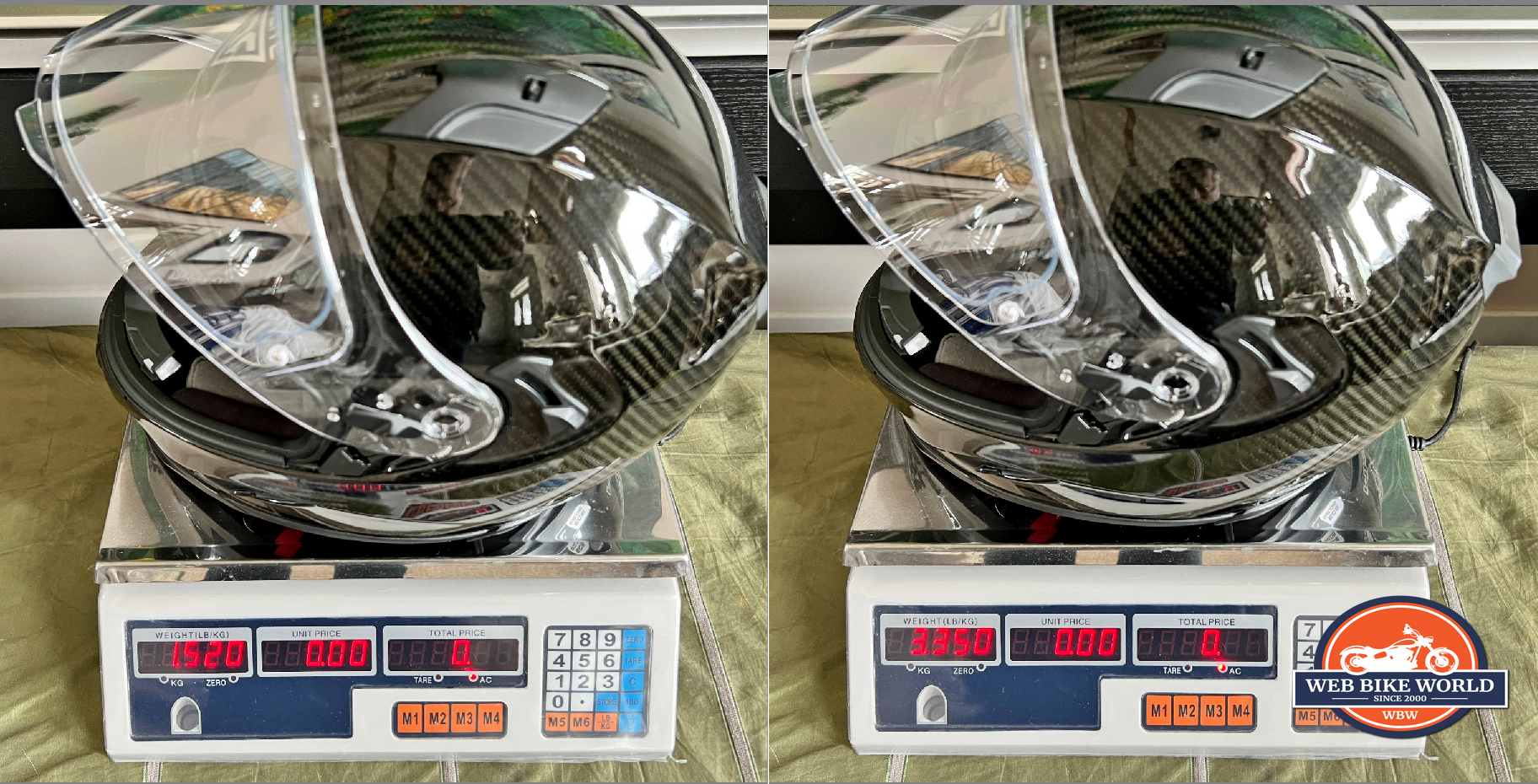
That’s impressive considering this helmet has a drop-down sun visor and a full electronics module complete with a camera and speakers on the inside!
When I wear it I don’t notice the weight in any negative way because it’s only 0.35 lbs heavier than my lightest helmet the Klim Krios Pro. Bravo Forcite!
Interior
The comfort liner is made from smooth microsuede that is washable, antimicrobial, and quick drying as is standard these days in most helmets worth talking about.
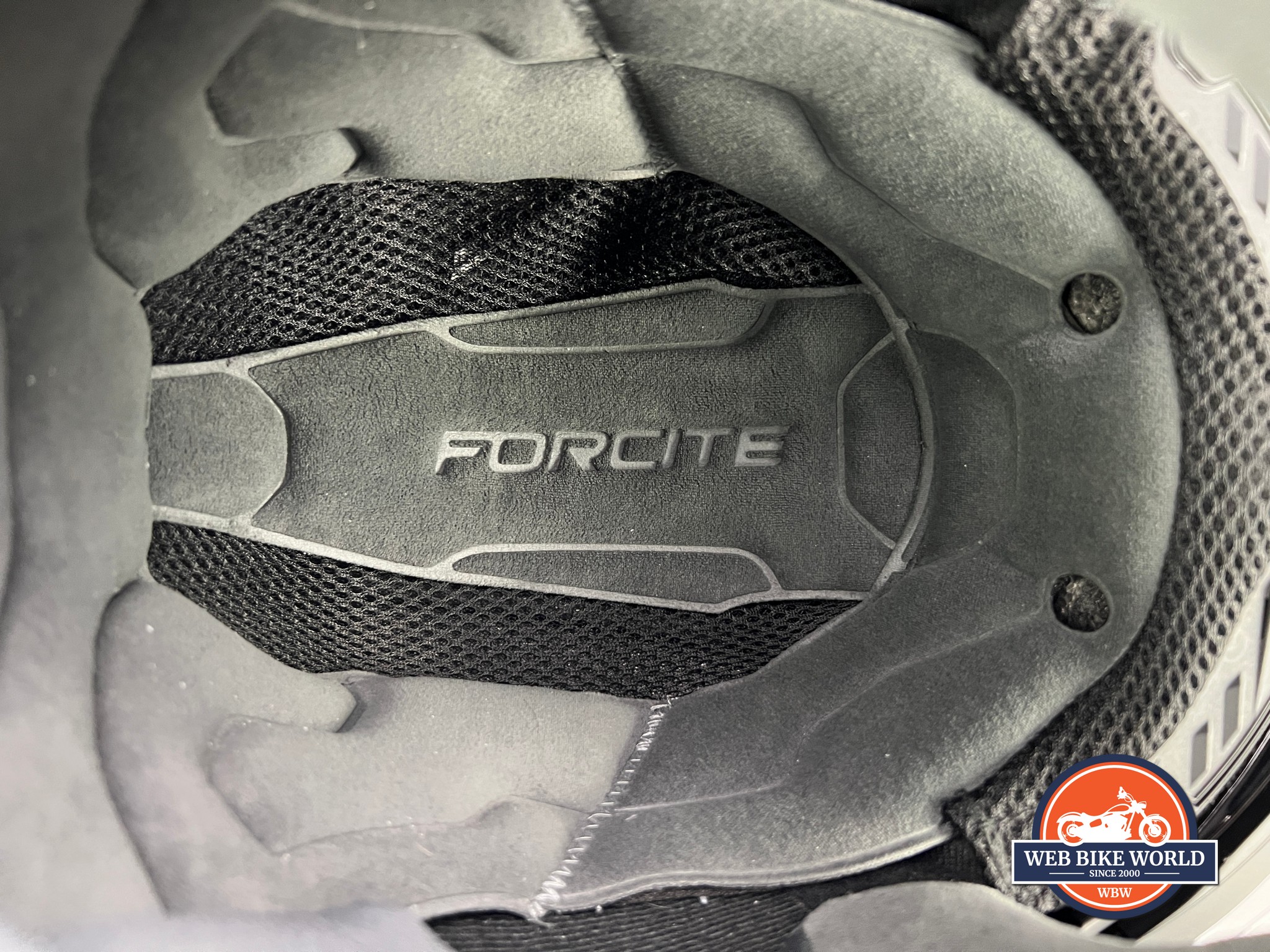
The cheek pads are nicely concave shaped to cradle my face and so far the soft material hasn’t begun pilling or wearing unusually fast after about 800 miles of riding against my coarse, bearded face.
The Abrasive Nylon Mesh
The only thing wrong with the MK1S interior is the very coarse mesh adorning the crown liner directly in front of where my forehead resides.
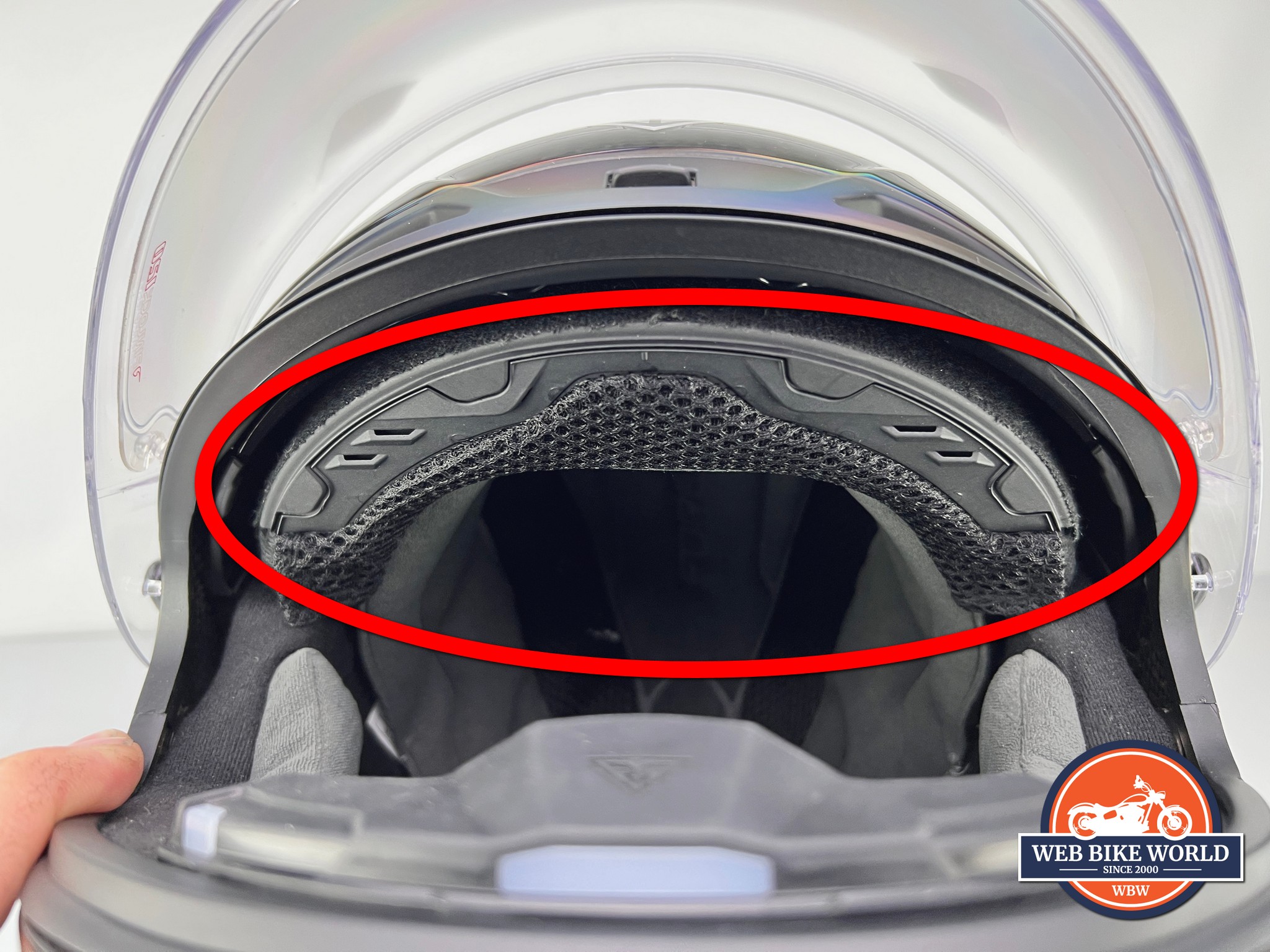
The liner material gets pulled inwards and rubs ferociously on my forehead whenever I put the helmet on. After an hour or more of wearing it, this chafing produces a visibly red patch on my forehead resembling a 3-inch-long rash.
I installed a piece of two-sided tape behind the liner in an attempt to stop it from pulling inwards with no success. The mesh seems to have stretched now and still has its way with my forehead on longer rides.
My suggestion to Forcite is to replace this mesh with the same soft microsuede found everywhere else in the liner.
The Chinstrap
There’s nothing overly important to discuss about the chinstrap on this helmet other than to note that I find it difficult to attach the excess length to the waiting snap on the left side.
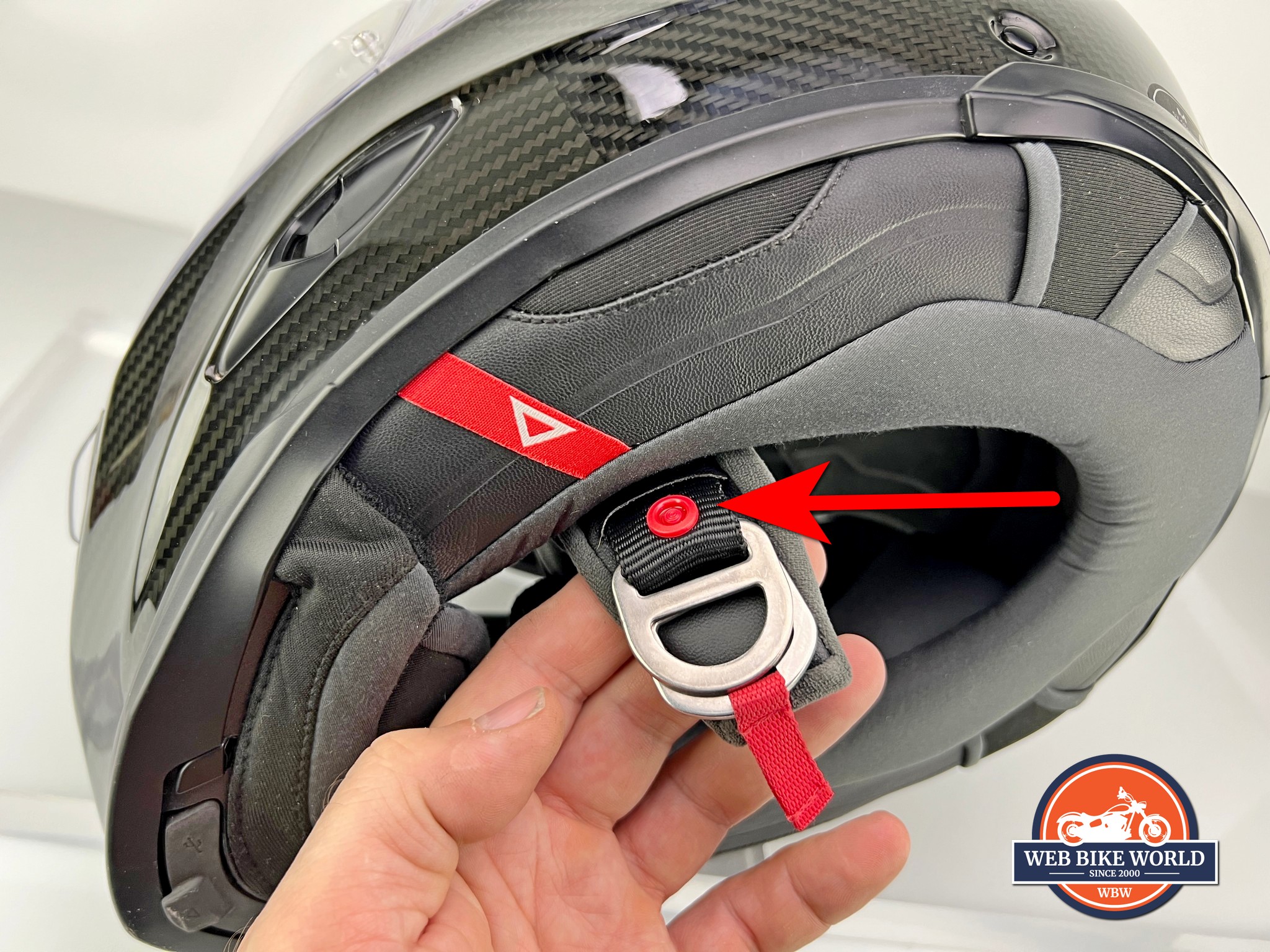
When I’m wearing gloves the snap is extra hard to locate and attach because it seems to partially disappear up into the helmet.
MK1S Visor and Field of View
The Forcite MK1S eyeport is the perfect size and shape to get a good look at the world around you while riding. Peripheral views are unobstructed and I can succinctly say they hit the target.
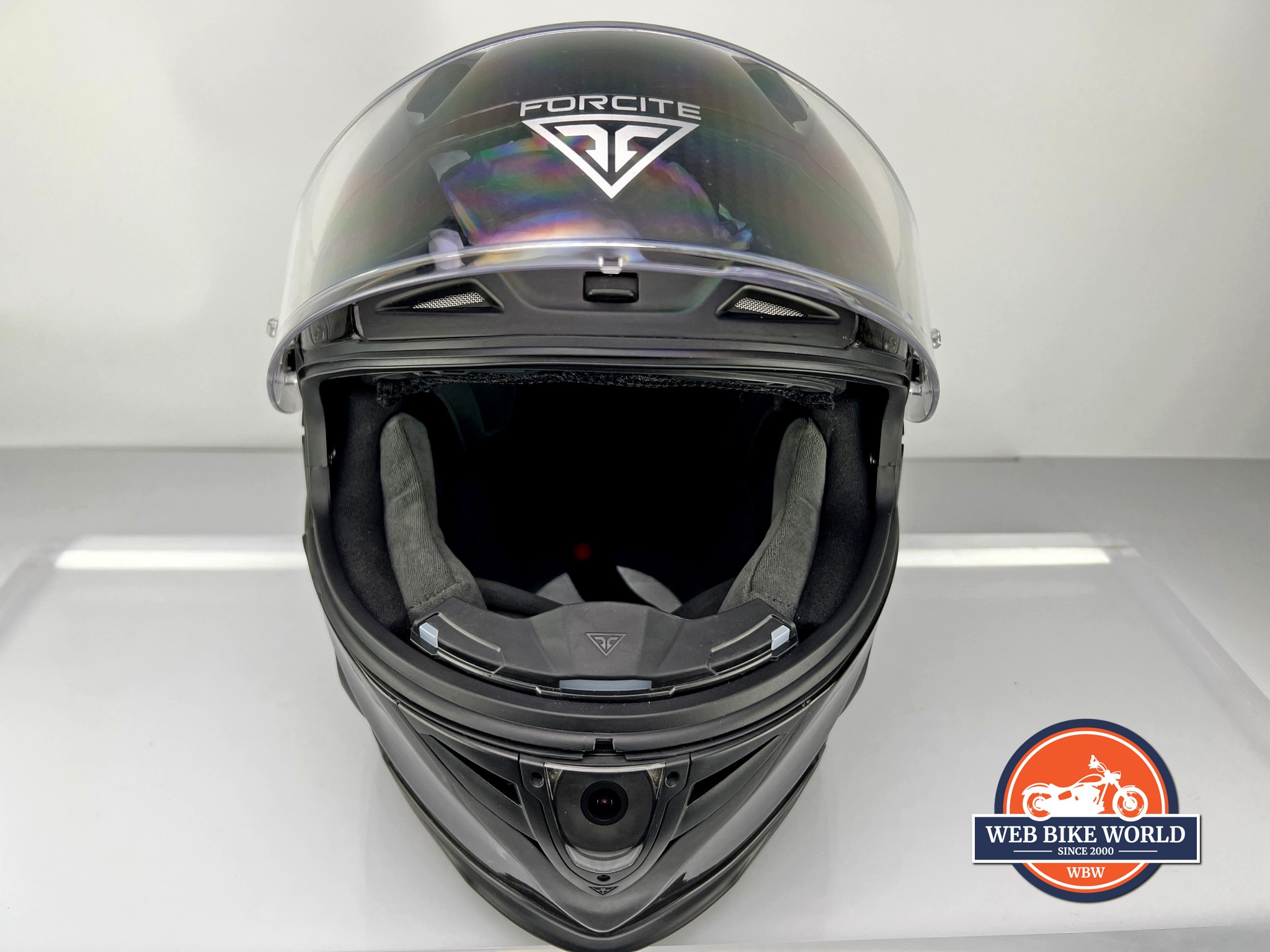
This is all the more impressive because they had to factor in the LED display running along the bottom edge not becoming an obstacle.
Bug Guts Didn’t Faze It
I’ve tested many helmets for wBW and I can’t think of one visor that didn’t sustain at least minor scratches during the testing process. I always purposely use my gloved hand to wipe away rain, dirt, and bug carcasses to gauge the quality of the material during my testing.
To my surprise, the clear MK1S visor remains scratch free at the time of this writing! That’s a huge feather in the Forcite cap.
Integrated Drop-Down Sun Visor
There’s an untouched tinted visor waiting in the MK1S box for me to test but I’m not going to bother because the helmet already has a built-in, drop-down sun visor that is a bit darker than average on the MK1S. It’s been more than sufficient for my needs thanks to the complete coverage it provides when fully lowered.
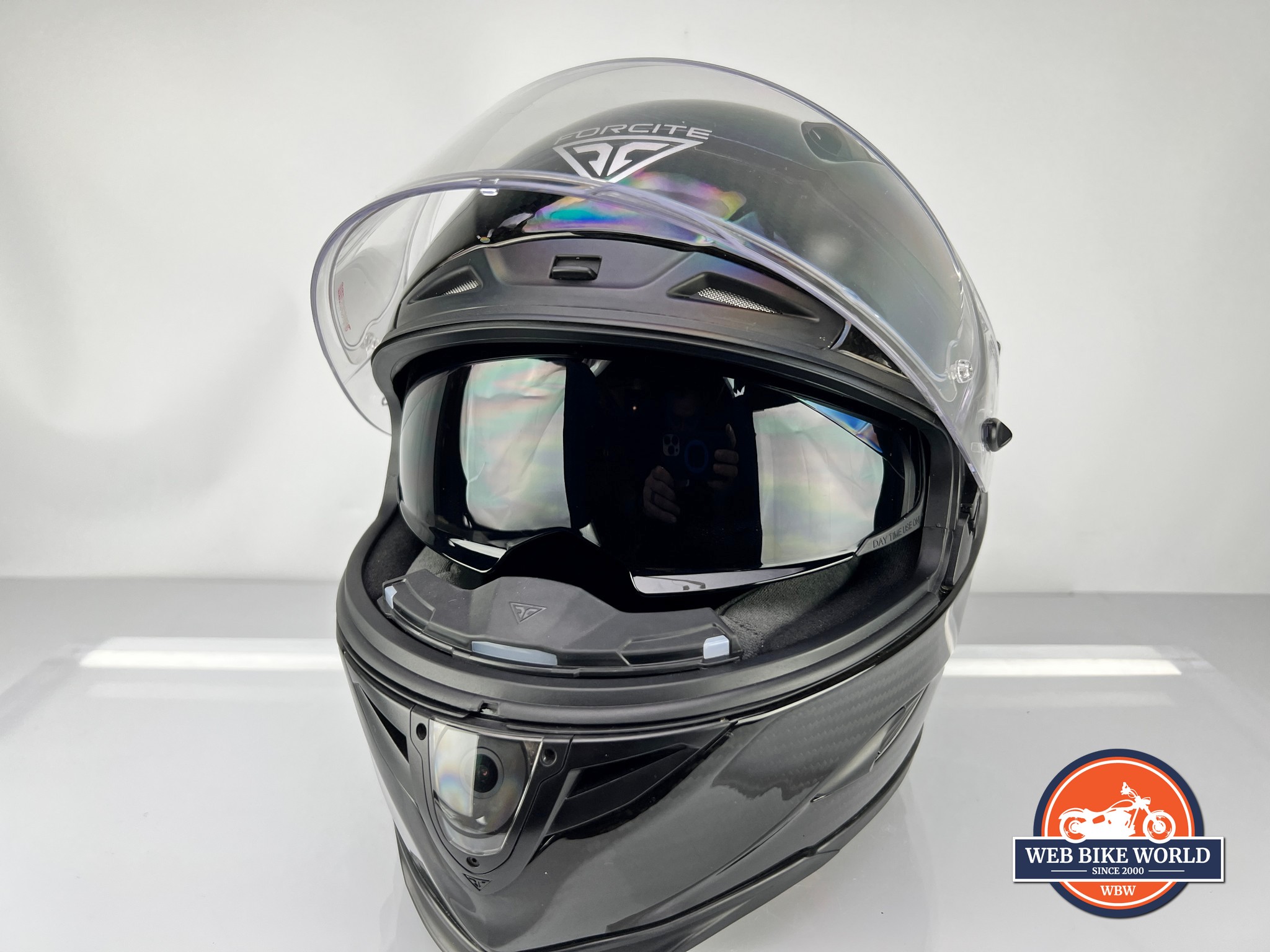
The mechanism to lower/raise the sun lens hasn’t missed a beat mechanically speaking but the lens does fog up when riding in colder weather. I can clear that mist easily with a quick blast of air from opening the main visor.
Now for the bad news, my North American friends… the drop-down sun visor won’t be a feature on the DOT-certified MK1S sold in North America.
A Pinlock 120 Comes Included
Included with the helmet comes the Pinlock 120 to keep fogging on the main visor to a minimum. If a Pinlock didn’t come with the helmet I would cry foul because Forcite bills the MK1S as premium.
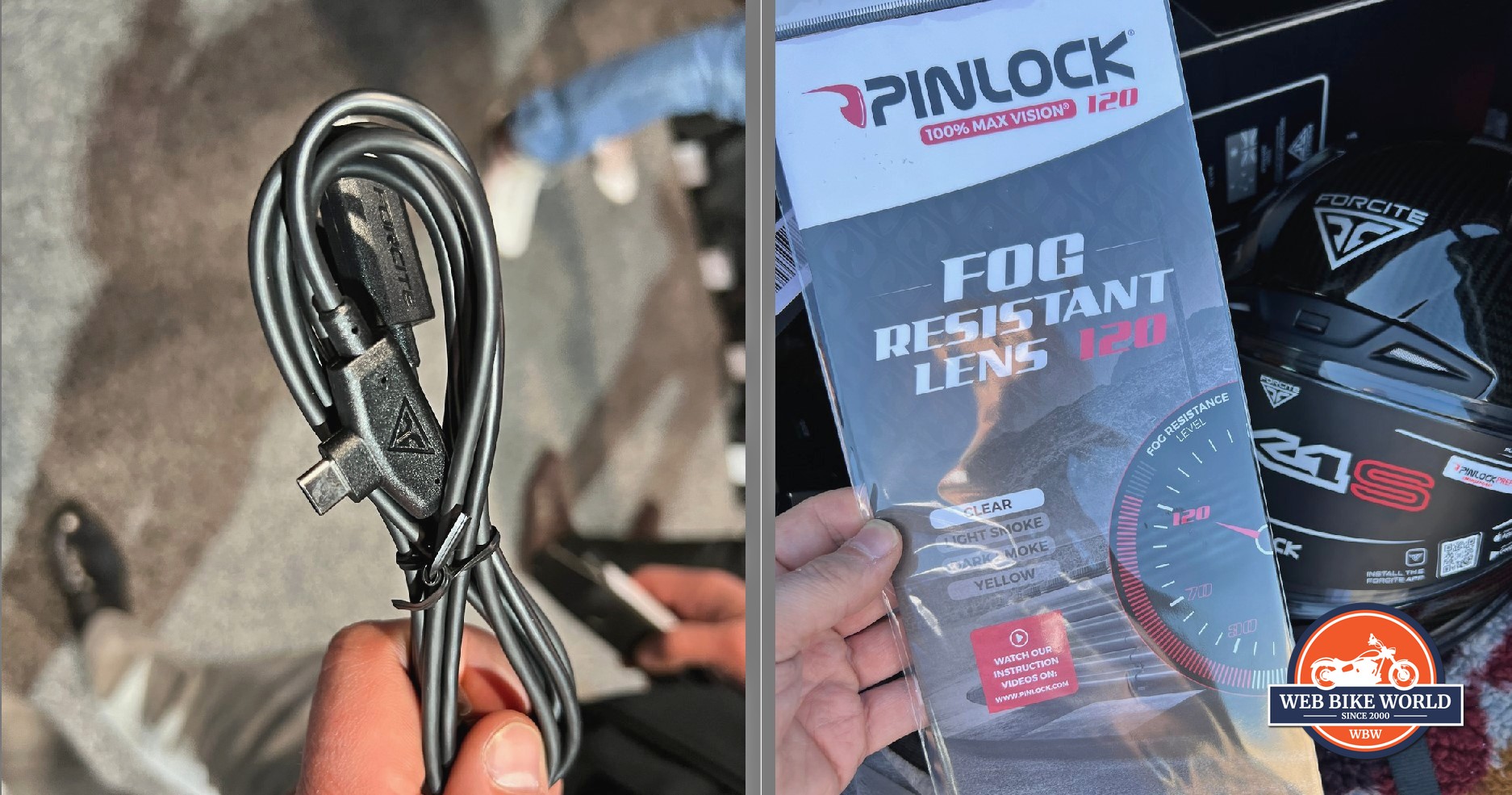
Good call including this, fellas!
Quick Release Mechanism
Removal of the main visor is easy thanks to the quick-release latches on either side. The only important thing to remember is to ensure both locking tabs are in the unlocked position before attempting to remove or install the visor.
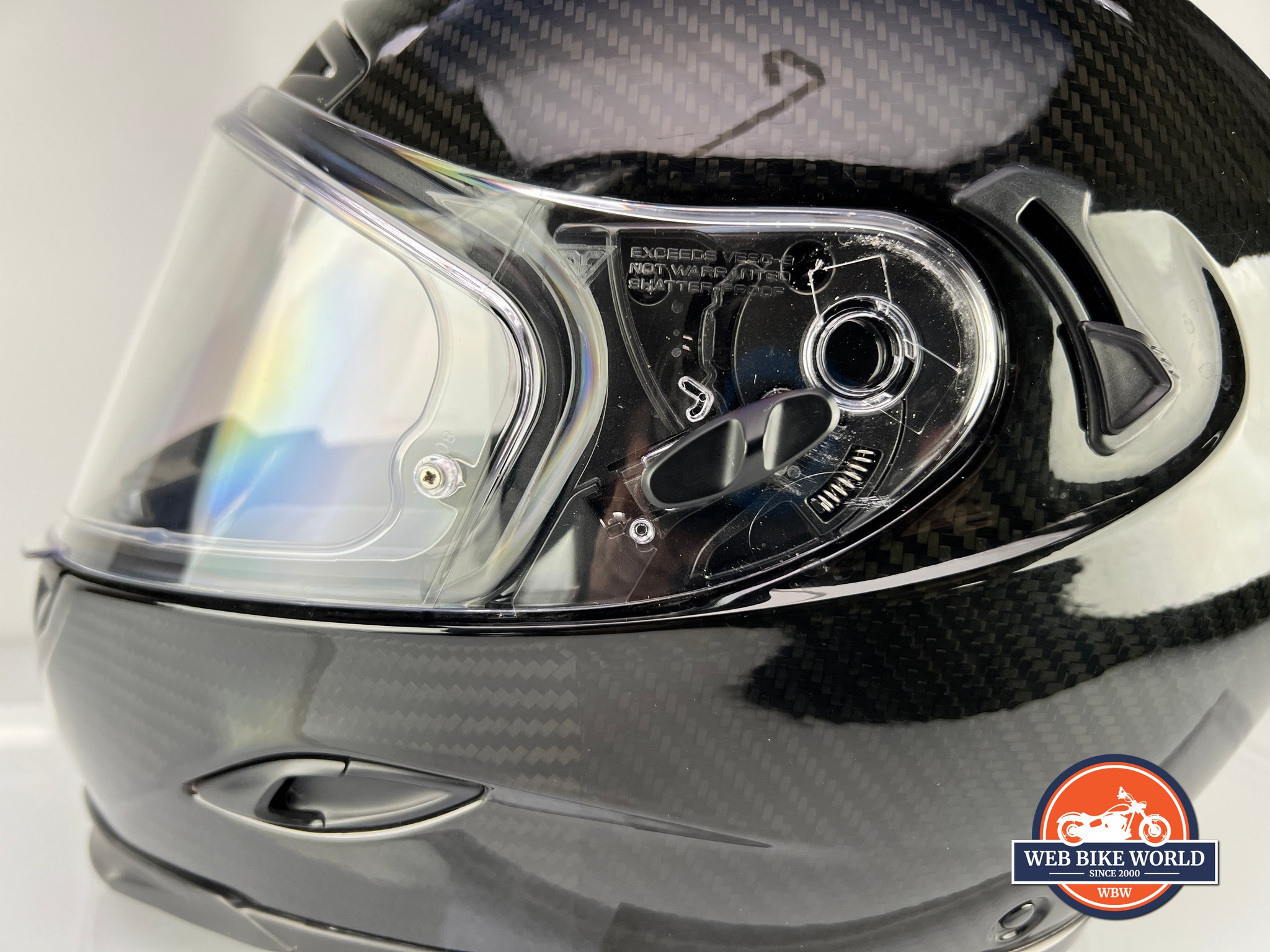
Visor Adjustments
I’m a visor snob and often will groan about clunky and noisy detents when it irritates me enough on any given helmet.
The MK1S visor pleases me with its smooth action and quiet detents, but I’m unsatisfied to find the first locked open position of the visor isn’t what I call a “defogging” or barely cracked open gap.
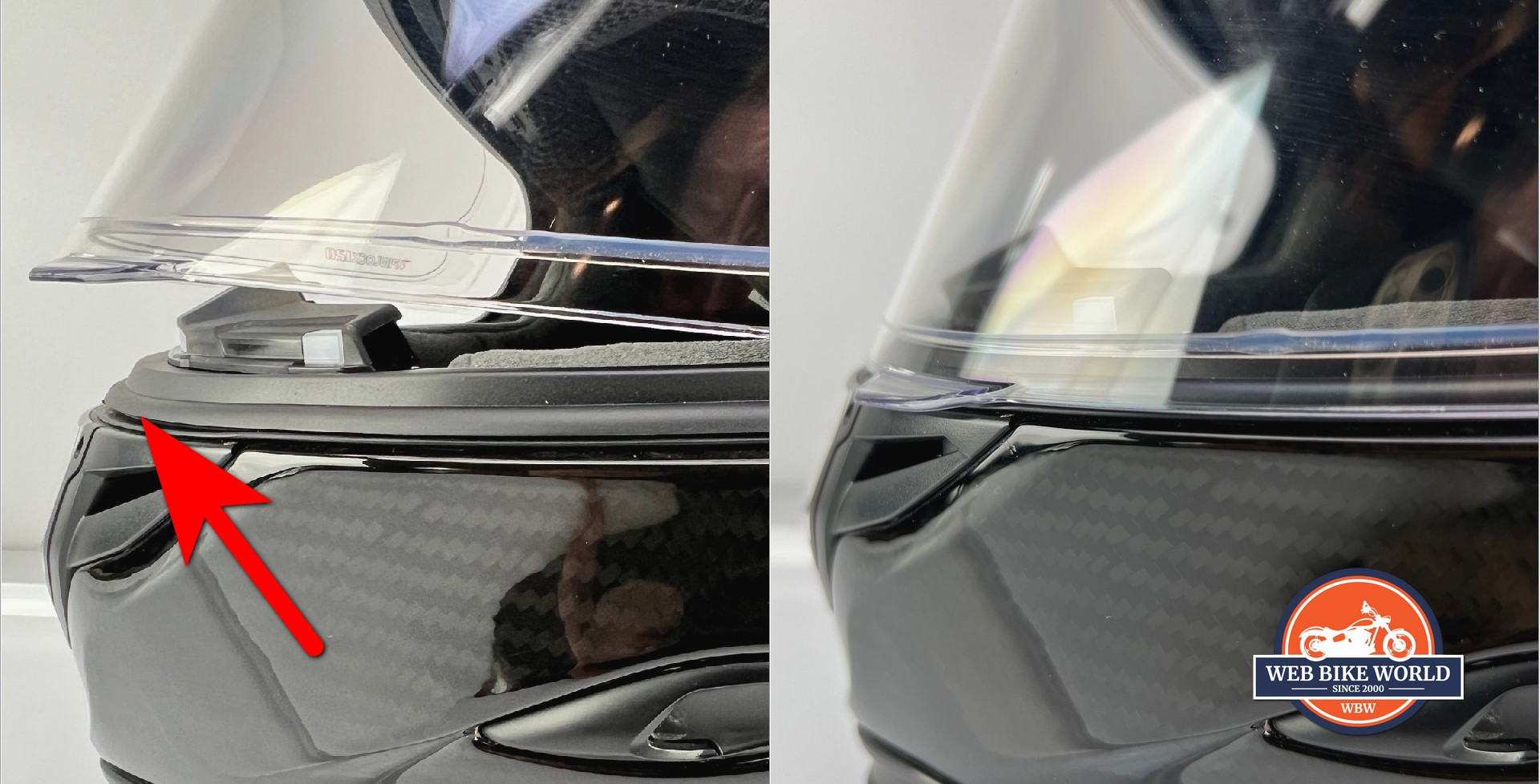
Instead, the first available open position produces a large gap of around 1” at the front of the chin bar.
MK1S Helmet Ventilation
The 7 vents on the MK1S (6 in front, 1 rear) work together adequately in cooler weather but I find the airflow hard to notice in hotter weather.
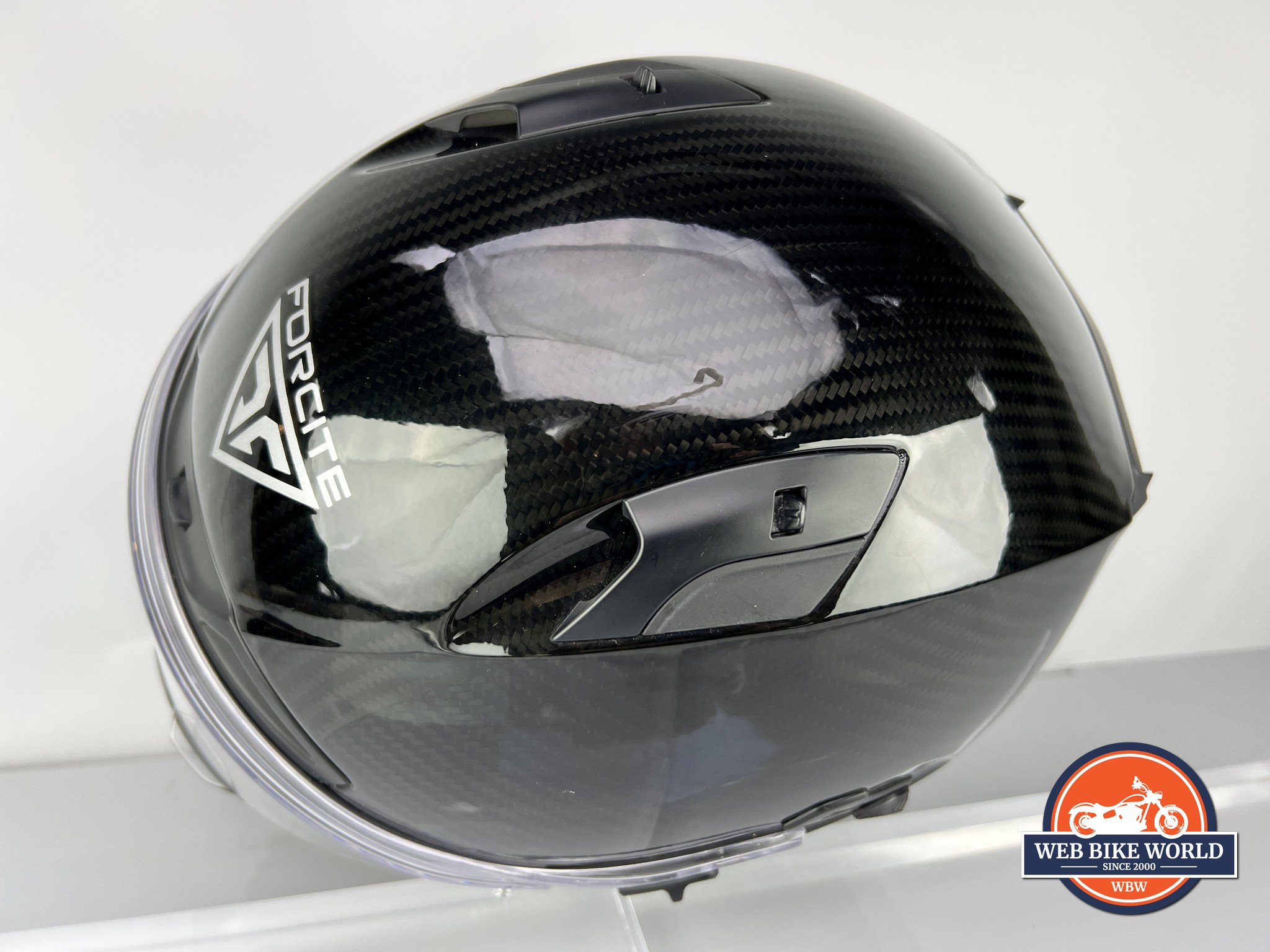
The switches up top are easy to locate and reposition despite their small size as is the one just above the eyeport and the rear fin/airfoil switch.
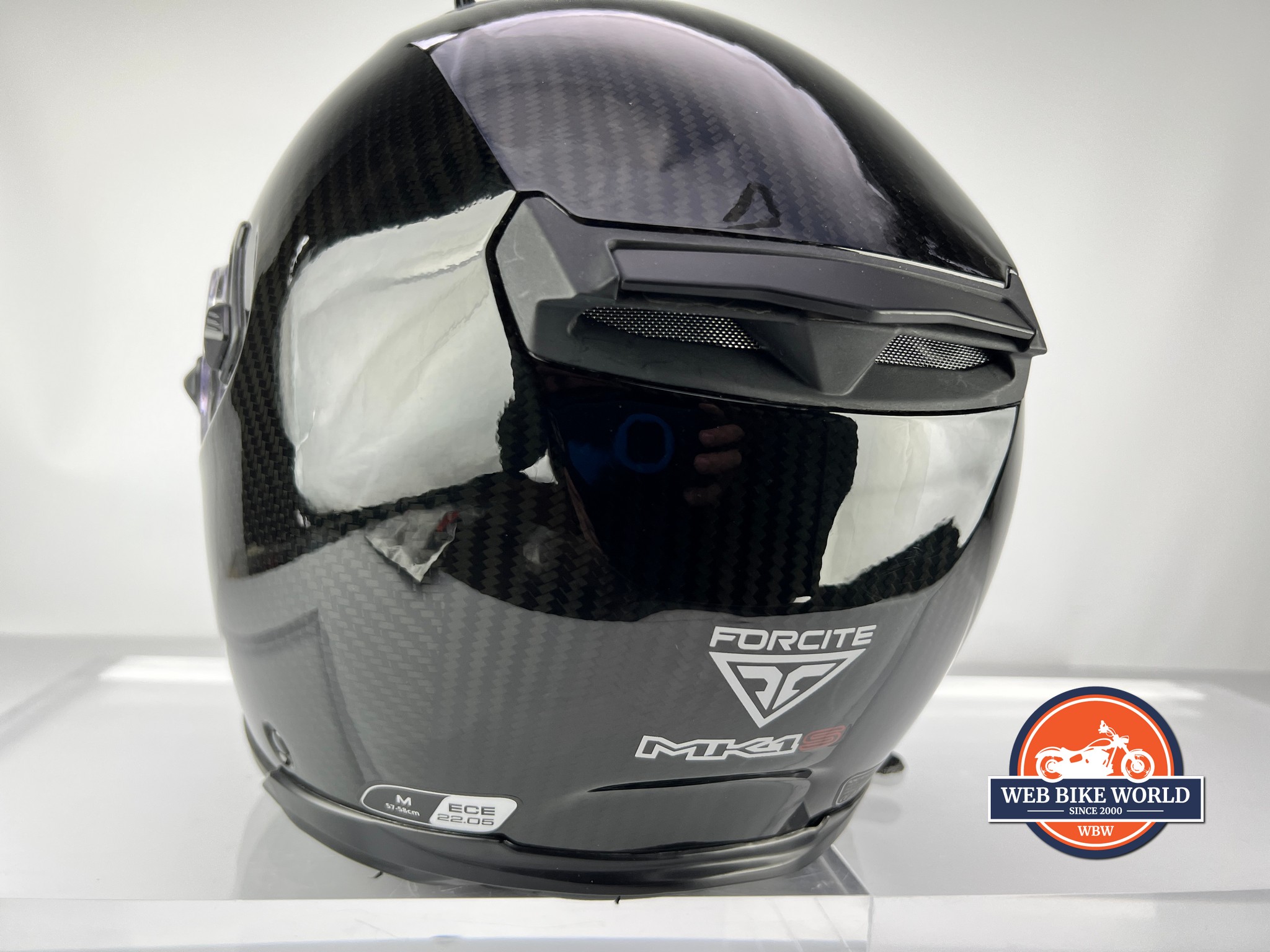
The chin bar ones are located on the inside of the chin bar and aren’t easy to manipulate especially while riding. In fact, I’d rate it inadvisable to attempt moving those switches while on the move because your hand will block the view of the road ahead.
The MK1S Out On The Road
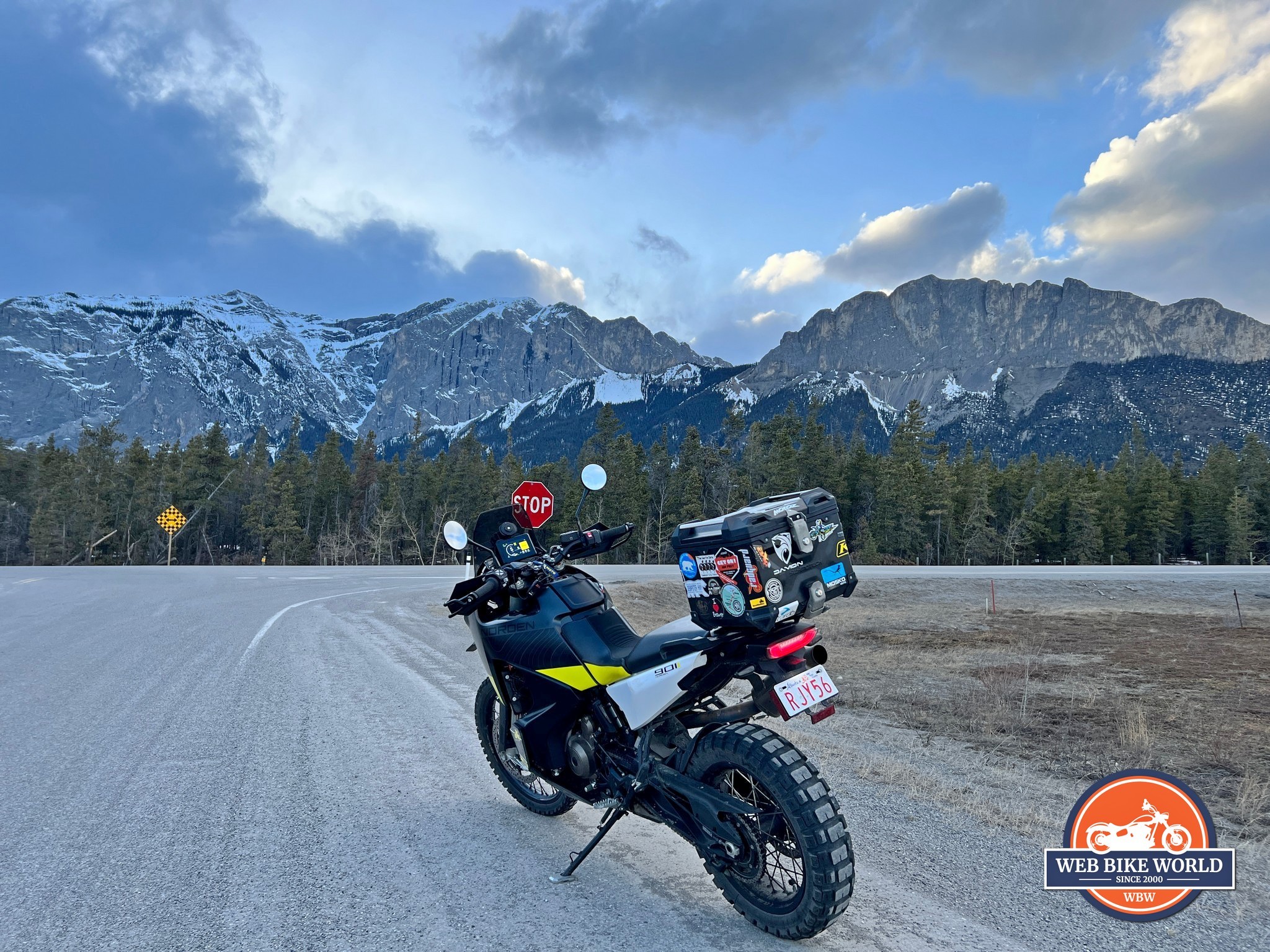
I’m reasonably sure that I’m the only person to ride with the Forcite MK1S in both the United States and Canada at this point. As such, I can offer up some unique insight into its performance north and south of the 49th parallel.
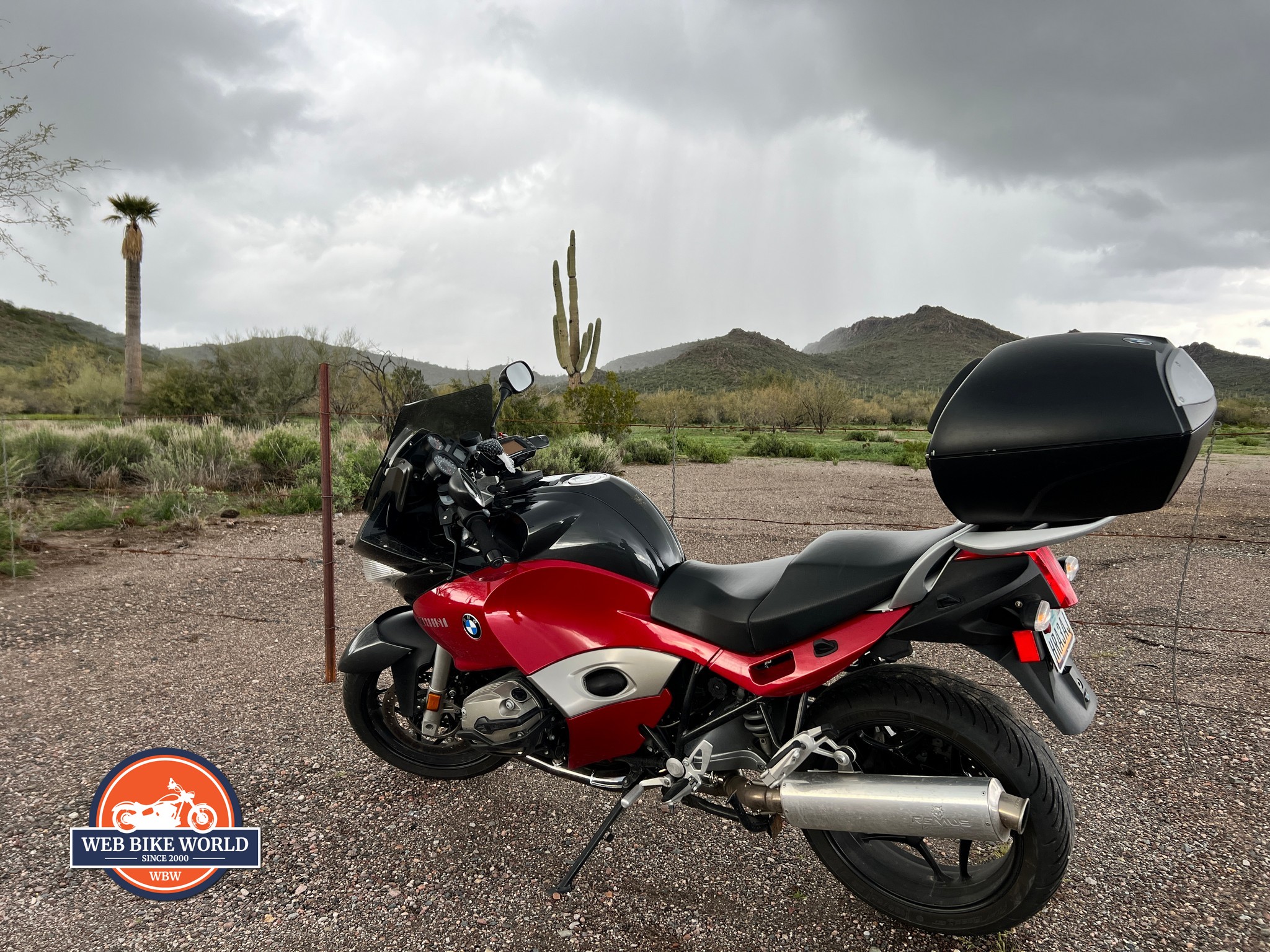
Arizona Riding
I first got my hands on this sample MK1S in Las Vegas at the 2023 AimExpo Motorcycle Show but I couldn’t legally rush out and immediately start riding with a non-DOT-approved helmet in Nevada. Technically I could have, but I didn’t want to break the law intentionally.
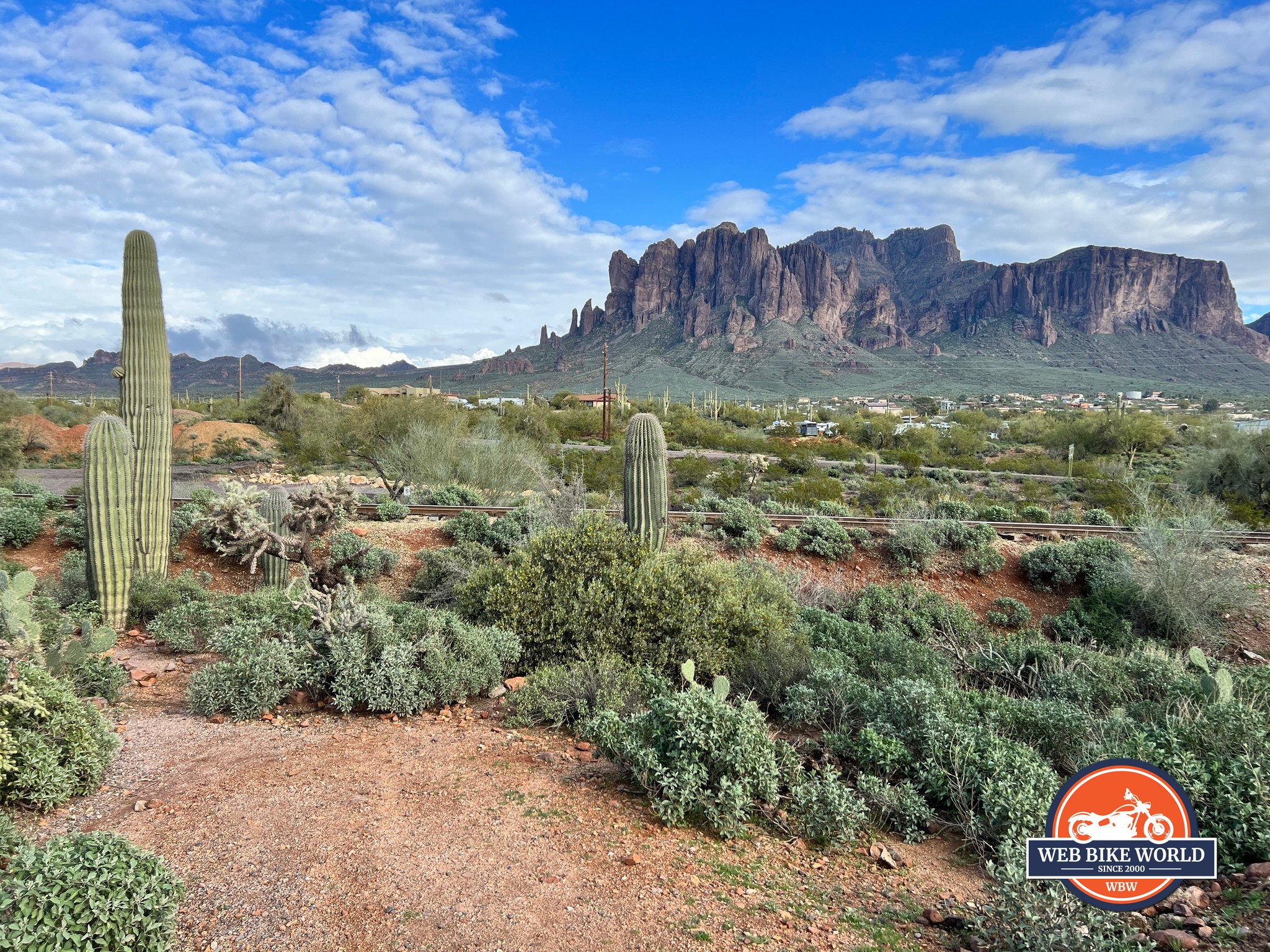
Fortunately, the motorcycle helmet laws in neighboring Arizona allow adult riders to wear any kind of helmet (or no helmet), so I excitedly did my first round of testing around Phoenix using a rental BMW R1200 ST.
Road Noise
Carbon fiber helmets typically are noisier than average in my experience, and so are race-styled helmets. Carbon fiber racing helmets are most definitely not quiet at highway speeds and that’s the case with the MK1S.
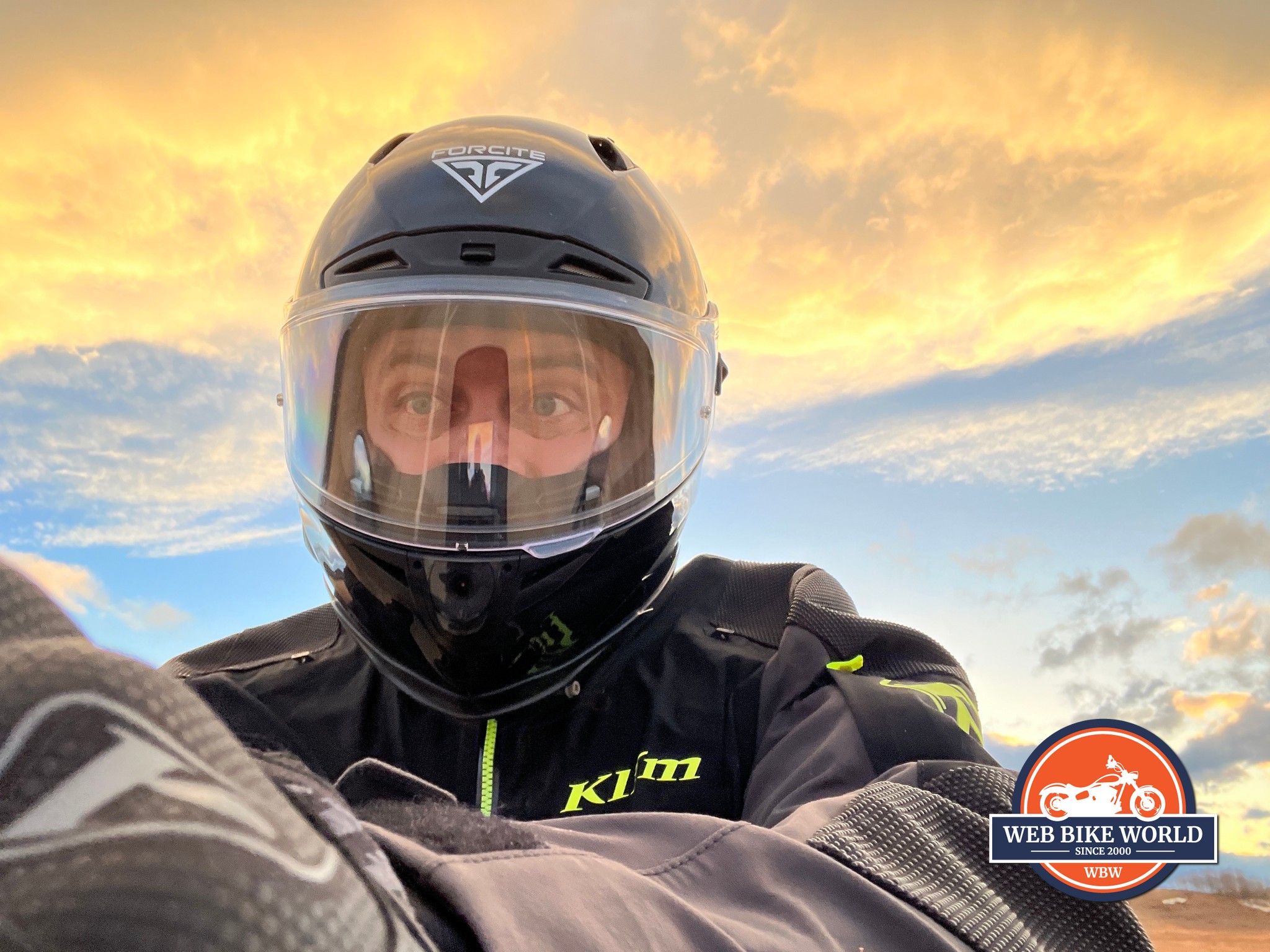
It’s likely caused in part by the shape of the top vents but I haven’t put much effort into pinpointing it because what I’ve noticed is that most riders these days wear earplugs and so road noise isn’t a large concern anymore.
Rain Riding
The MK1S got a hostile welcome from the Phoenix weather in the form of 2 straight hours of constant precipitation. I thought AZ winters were warm and dry?! No one was more surprised than I was to encounter a deluge like that in the desert. Wow!
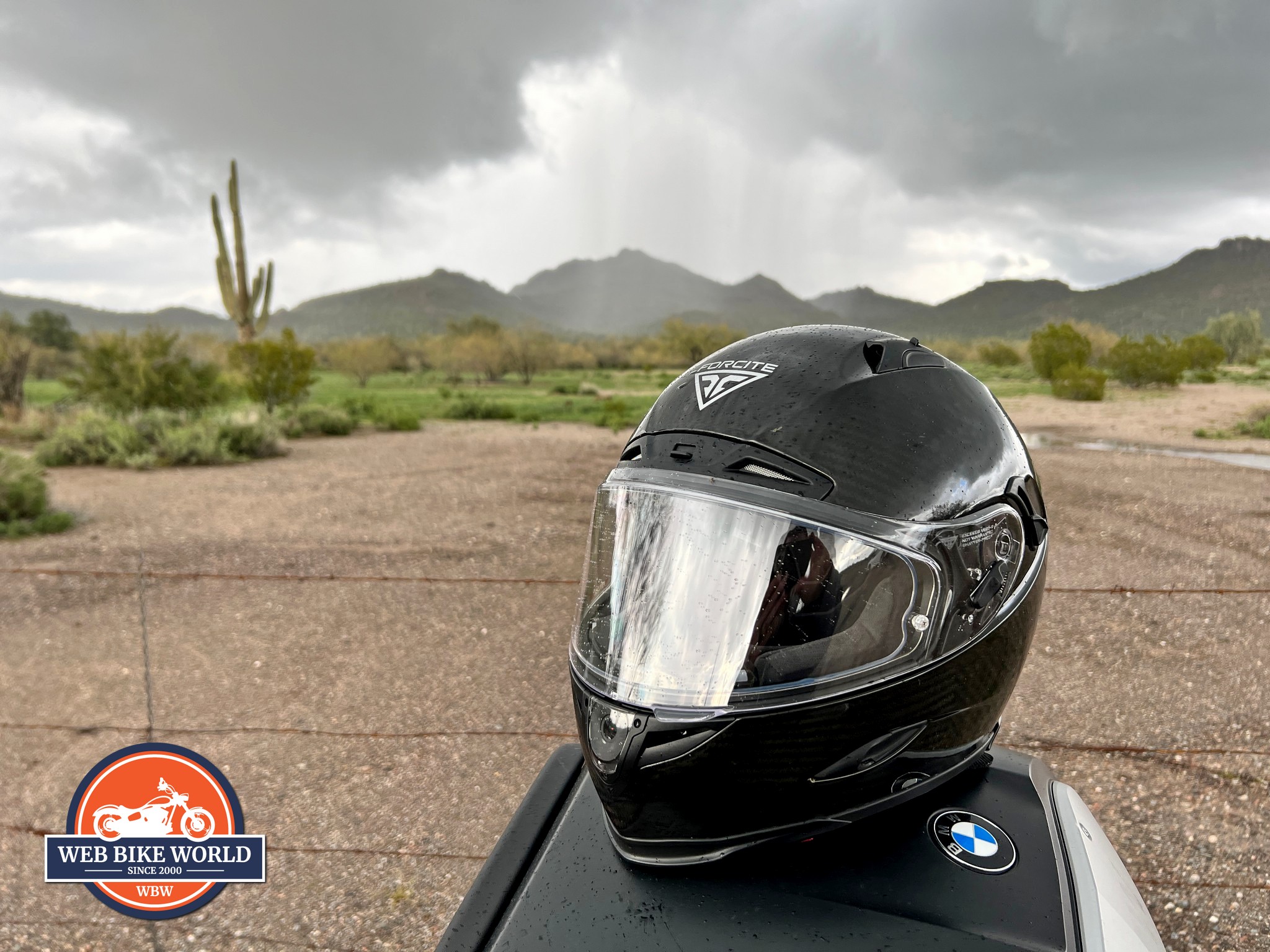
The helmet impressed me by shrugging it off like the champ it is. The majority of helmets I ride with in heavy rain develop leaks around the visor seal, but this Forcite design shined and nothing got through at all. Bravo!
Lift and Pull
In crosswinds and headwinds, the MK1S refused to try breaking or straining my neck. I credit the smooth, aerodynamic shell for this luxurious treatment.
Being that I’m an avid adventure rider I’ve grown used to the wind ferociously grabbing the peak on my usual helmets to create neck fatigue. The Forcite was a pleasure to wear at any speed I took it to although I never hit racetrack levels of velocity.
Got Hi-Viz and Reflective Materials?
This is a complaint I make with nearly every helmet: the lack of hi-viz and reflective paint/decals.
Kudos to Forcite for having the… foresight to include two reflective decals on the MK1S. The logos on the front and the back both light up beautifully when light strikes them at night. Full credit to them for finding an aesthetically pleasing way to integrate a safety feature! Bravo again!
I would encourage them to include some fluorescent pinstriping or something similar on the next generation they build to further enhance the chance of getting the attention of car drivers on the road.

Recently a fancier version of the MK1S was released called the MK1S Nexus Edition complete with extra cool-looking graphics designed by Drudi Performance (as found on several Arai helmets). The exterior has striking visuals in the form of purple and white stripes which could easily be made fluorescent if Forcite decides to do it.
MK1S Smart Technology Performance
Up to now this review has played out like any other I’ve written but that’s about to change as I delve into what makes this helmet Smart and special: the tech module.
Initial Setup
Forcite has done such a great job making the activation, cordless (over the air) firmware updates, and initialization of the helmet and connection from the helmet and handlebar controller to an owner’s smartphone easy— if you follow the directions in the Forcite app exactly. Any deviation seems to cause lag, confusion, and the bugs to come out so trust me when I say just let the app guide you as opposed to manually pairing devices to your phone and you’ll have way fewer problems.
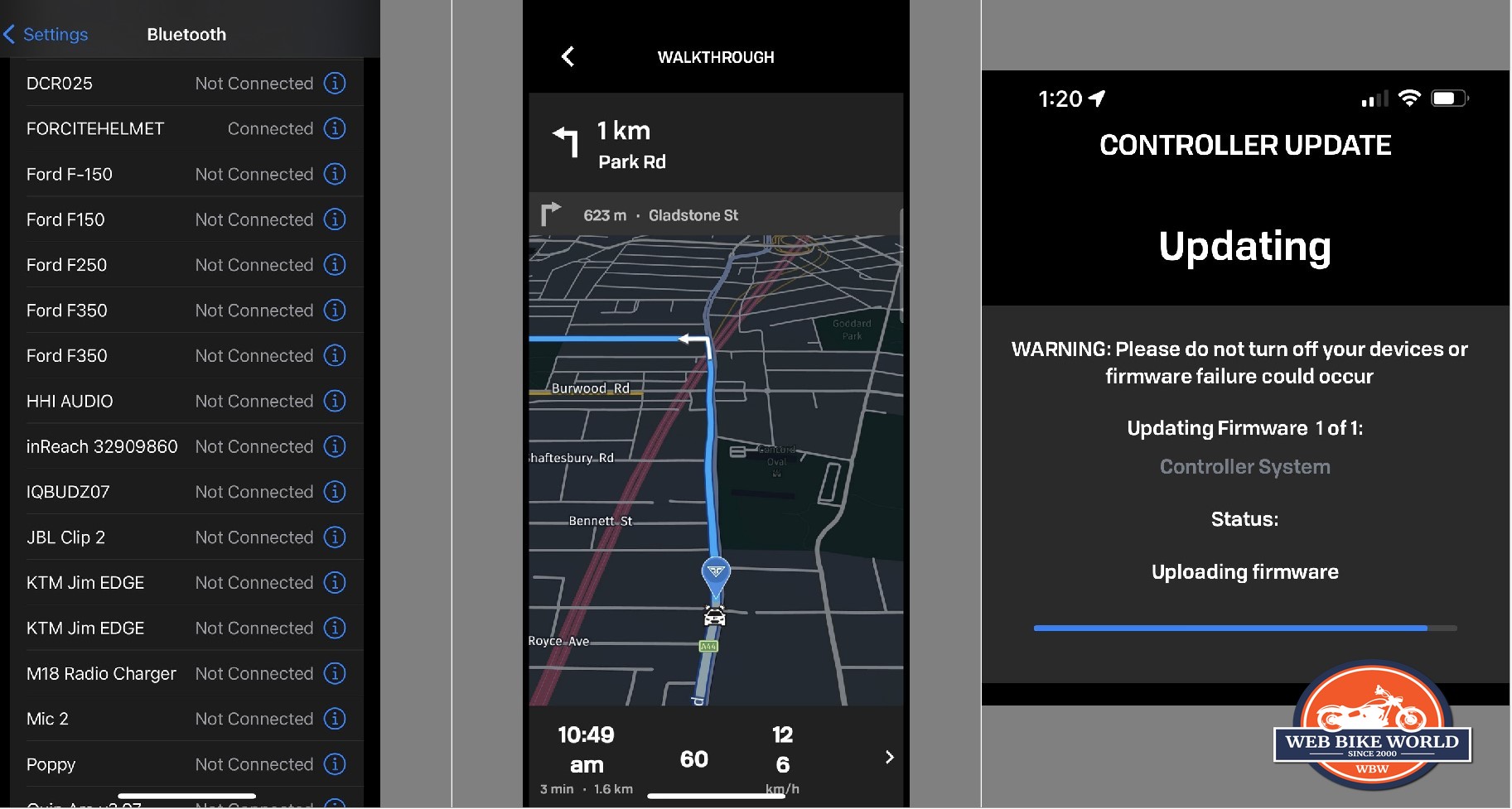
The Forcite App Is Unmoved
When I ride my Norden 901 I use a QuadLock 360 mounting system to hold my iPhone 13 Pro Max horizontally above my dash.
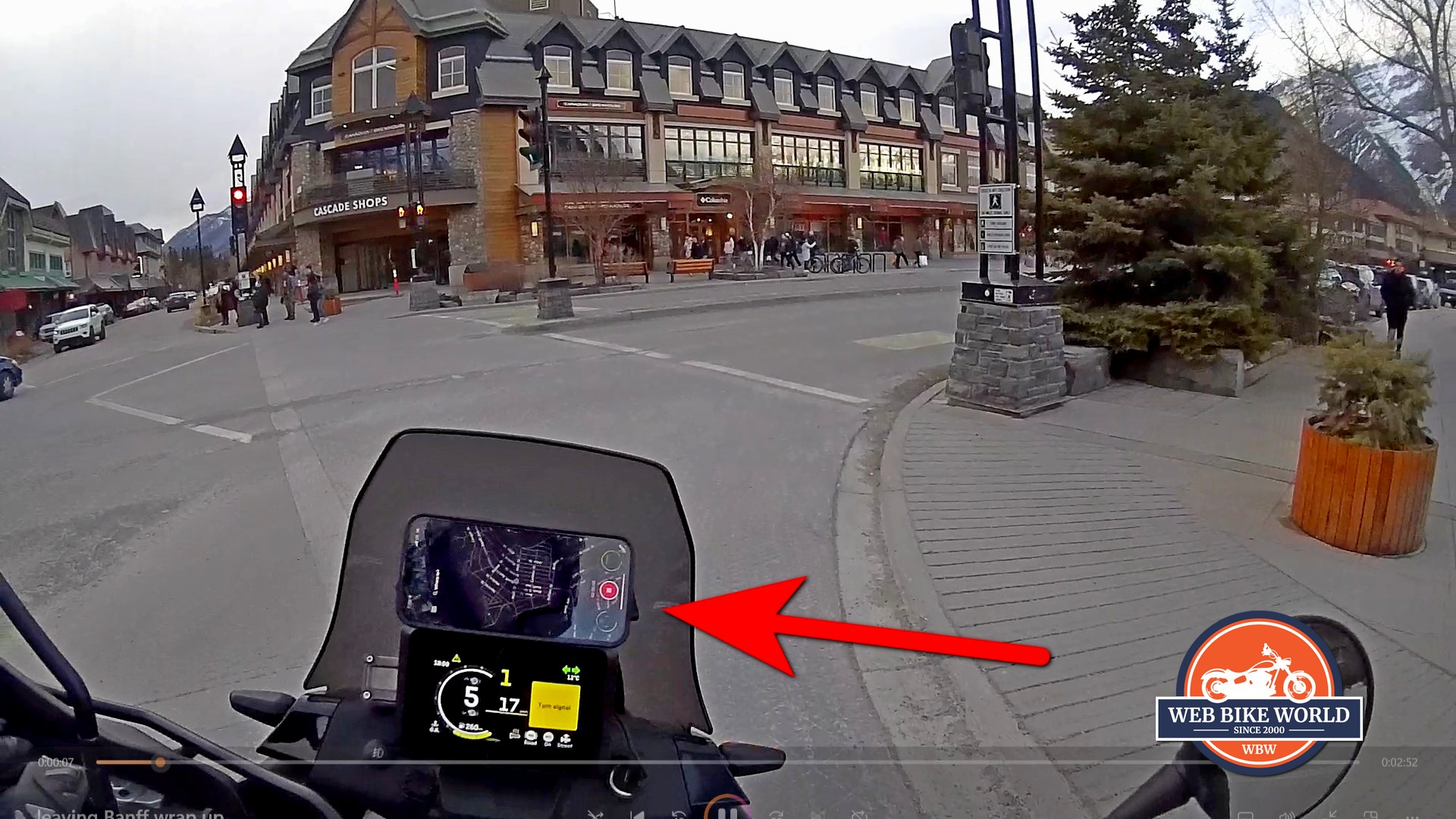
When I use Google Maps the map rotates 90 degrees to match the horizontal position of the iPhone, but the Forcite app won’t. It genuinely surprised me to see that since I would imagine it’s not a difficult option to program into an app, but then again I’m a reviewer and not an app creator.
The Handlebar Controller
As mentioned, my first ride in Phoenix with the MK1S was in torrential rain, and at first, everything worked perfectly despite the inclement weather! I was really pleased with the system as it directed me through the busy Phoenix rush hour with ease.
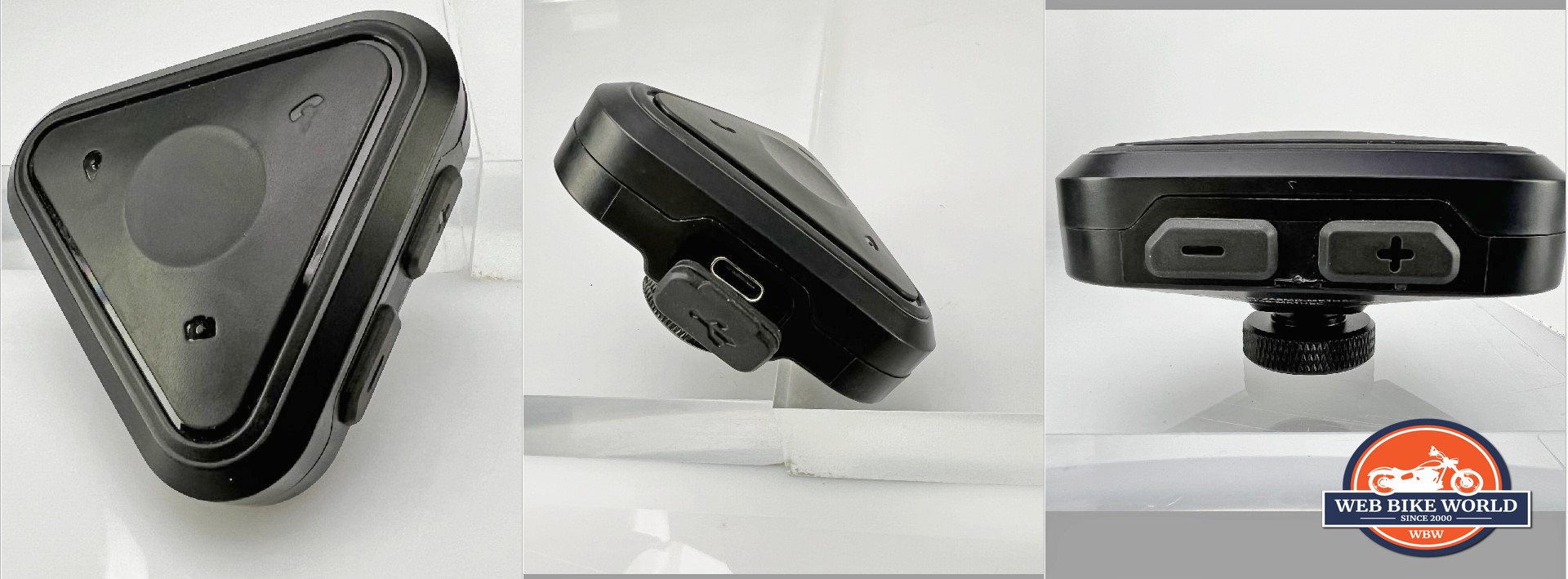
At some point later during that ride, the rubber plug for protecting the charging port on the handlebar controller might have dislodged enough to allow some amount of water intrusion.
After that, it behaved erratically and began to malfunction to the point I had to stop using it. Specifically, the volume down button ceased to function and the HBC lost its Bluetooth connection to the app.
When I got back home to Canada, I dug out the HBC from my first Forcite helmet and updated its firmware to use in place of the new one. That HBC has functioned much better, but not flawlessly.
Glitches and Bugs
For some reason, it seemed like my helmet and both HBCs would occasionally only partially link with the Forcite app on my iPhone 13 Pro Max. Or perhaps better put, the pairing was successful on paper (the app showed all was well), but both devices wouldn’t always behave as intended until I deleted the pairing in the Forcite app and re-established it. This takes only moments to do, but it happened to me 4 times during my testing and was aggravating. One of these times I attribute to the water intrusion in the HBC.
Sometimes the camera wouldn’t respond to the HBC button to begin or end filming, while other times the phone app simply wouldn’t sync with the helmet or HBC at all.
The weirdest example of these bugs occurred when my phone’s music would play out of the speakers on my phone instead of through the speakers in my helmet, but navigational audio from the Forcite app was still heard coming from the helmet speakers. The HBC was still able to control the music along with all other functions and I double-checked to ensure the problem wasn’t due to a setting on my iPhone.
Most of the time during my testing everything worked well and as such I’m not overly upset at having to make these small “repairs” over the 800 miles or 1300km ridden with the helmet.
Response By Forcite
I notified my Forcite contacts about the HBC malfunctioning and they agreed it likely was water damaged. They offered to send me a replacement controller which was very nice of them, but unfortunately, some miscommunication led to me waiting three months before it actually shipped out to me. I’m actually still waiting for it to arrive, but I do have a tracking number for the package. ***update I finally did receive a replacement HBC***
The Camera
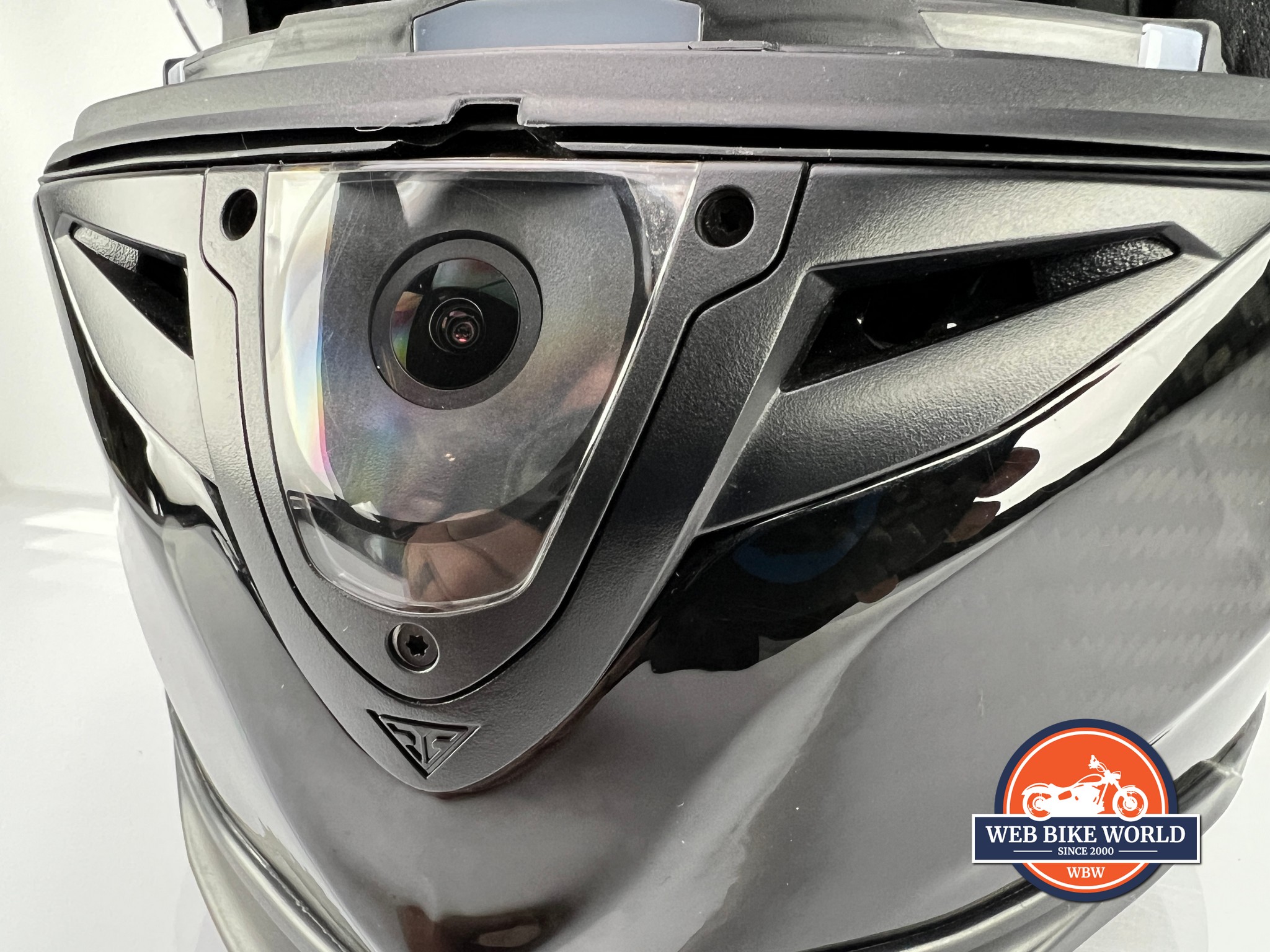
The camera didn’t fail me during testing despite some moisture threatening to bypass the clear outer shell as seen in the photo below.
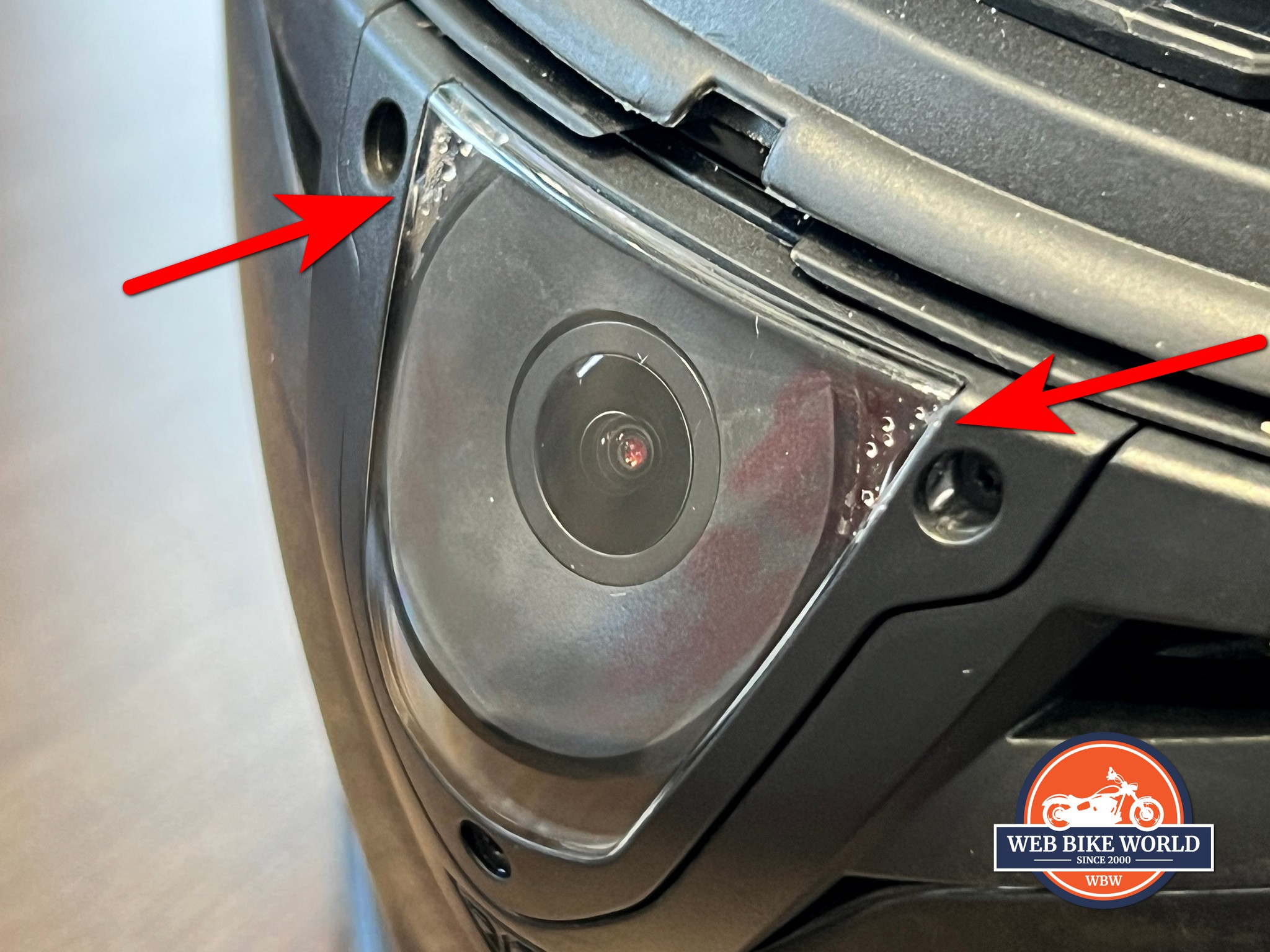
I was also surprised how rarely dead insects managed to splatter on the camera to obscure the footage filmed.
Pros:
- The MK1S integrated 1080p 60 fps camera does a great job of capturing video from the rider’s point of view without having a chunk of the right side obscured by the chin bar as with other Sena devices like the 10C Pro, 10C Evo, and 50C.
- The Camera never becomes dislodged or tilted off center as can happen with the Sena cameras, GoPros, etc. Peace of mind that the shot will be level is assured.
- Using either the Forcite app (or even better the included handlebar controller) you can start or stop recording video with the touch of a button in front of you as opposed to out of sight on the side of your helmet.
- The camera can record footage on SD memory cards up to 256G in size, but I used a 128G card in mine successfully. I didn’t manage to fill the card because after each ride I would download the footage to my laptop or my iPhone and clear the memory card after.
- Running solely on the internal battery while filming the camera can record for approximately 2 hrs, but the battery can be charged while recording easily from an aux port on the motorcycle to film longer.
- The camera records decent-quality footage even in low-light conditions
- Using the included cables video footage can be quickly downloaded from the helmet’s SD card to an Android smartphone or a laptop. iPhone users can also do this but have to spend $40 on a special Camera adapter.
Cons:
- There’s lag time between when activating the video recording feature (about 5 to 10 seconds) before the footage begins registering on the SD memory card.
- There’s no image stabilization feature on the camera
- There’s no option to snap a still photo using the camera like there is on the Sena devices
- The audio captured by the twin mics in the tech module is heavily degraded by wind noise and voices can sound quiet compared to audio captured by Sena devices (mic pickup level is lower and non-adjustable on the MK1S)
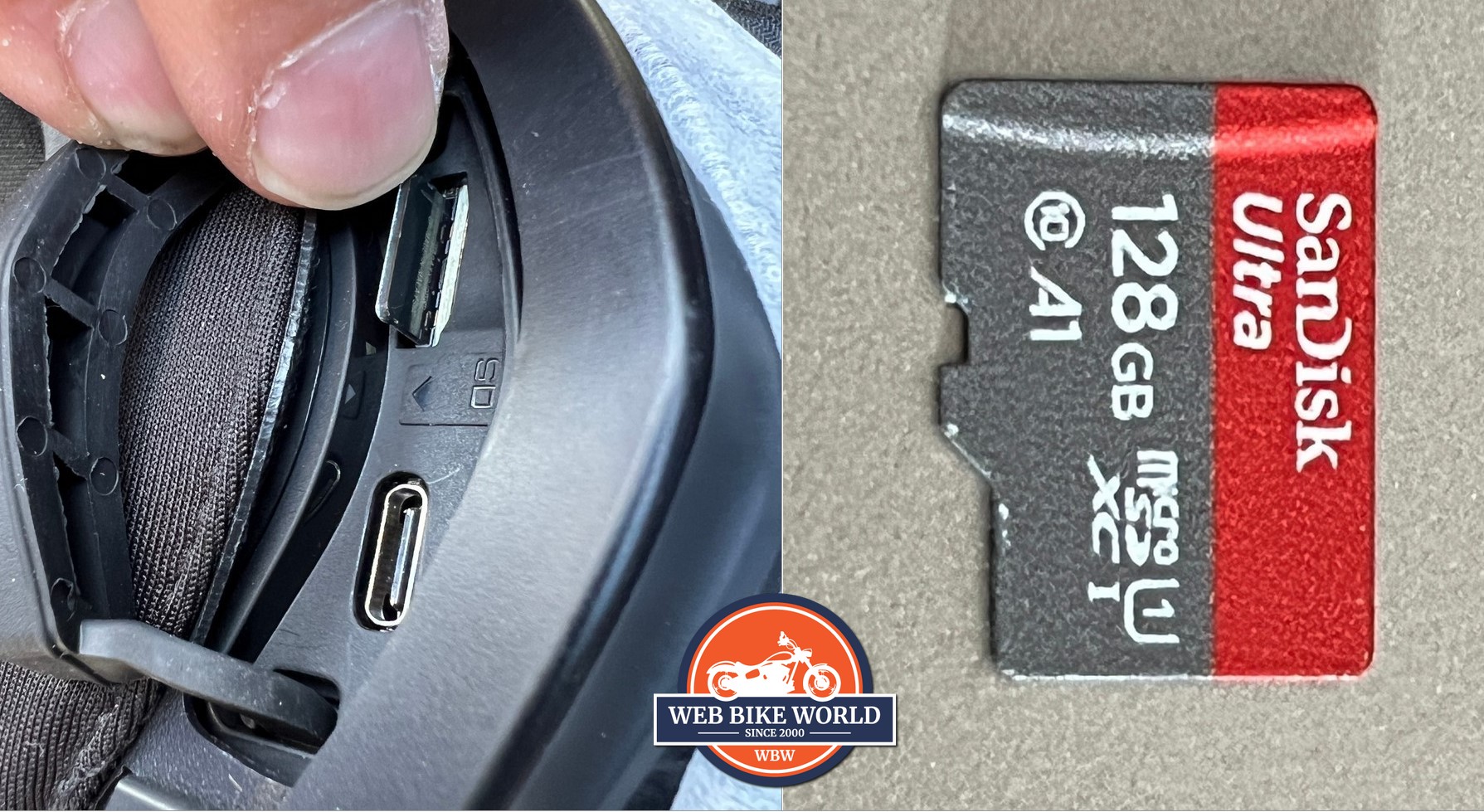
Retrieving video from the MK1S using your smartphone is possible without removing the SD card from the helmet using the AV cable included with the helmet. It worked flawlessly for me once I purchased the Apple camera adapter mentioned earlier.
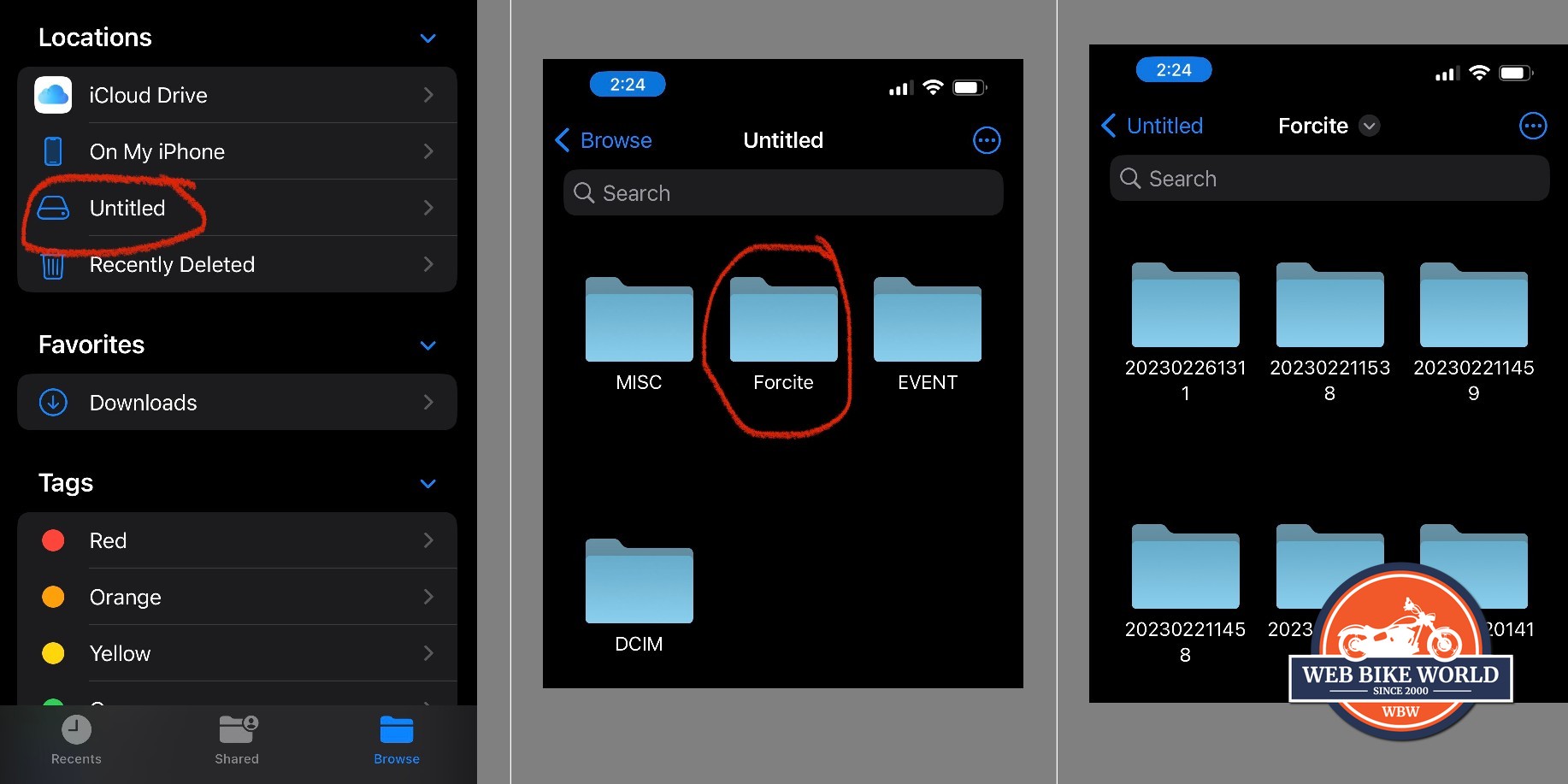
It’s not necessary to have the Apple adapter if you instead plug the AV cable into a laptop or desktop computer to retrieve your video files. That’s the way I typically do it.
Let’s Compare Video/Audio Recordings
Below is a video I filmed in 2019 using a Sena 10C Pro installed in an Arai DT-X helmet. The DT-X is a louder helmet than the MK1S (in my opinion) but you’ll notice how much better the recorded audio is at highway speeds comparatively speaking.
The Sena 10C Pro camera was recording in 1080p 60 fps in this video (the same as the MK1S does) so I believe it’s a fair comparison.
Now have a look at the video I recorded below using the Forcite near Phoenix.
Forcite should work to improve the audio quality in the MK1S by relocating the mics to protect from the wind and adding adjustable pickup levels in the Forcite app to better compete with Sena cameras.
It would also be nice to be able to snap photos using the camera as is the case with all the Sena devices.
Incoming Audio Not Recorded on MK1S Video
Here’s another difference between the MK1S and the Sena 10C Evo audio recording systems.
If you watch the video below you’ll hear my voice as well as the voice of my friend riding beside me on the Kawasaki H2.
2020 Harley Davidson Livewire vs 2015 Kawasaki Ninja H2 0 – 60mph
If I filmed this using the MK1S only my voice would be present on the recording even though I would hear my friend’s voice in my helmet. This also applies to incoming phone calls and navigational instructions from the Forcite app… basically, any audio coming through the in-helmet speakers.
If that’s what you’re after then you’ll like the MK1S for your vlogging needs. For myself, I want the audio recorded on my videos as with the Sena cameras.
The Harman Kardon Speakers
Forcite chose fantastic speakers for the MK1S. These babies provide ample volume, clarity, and even bass when positioned correctly in the helmet.
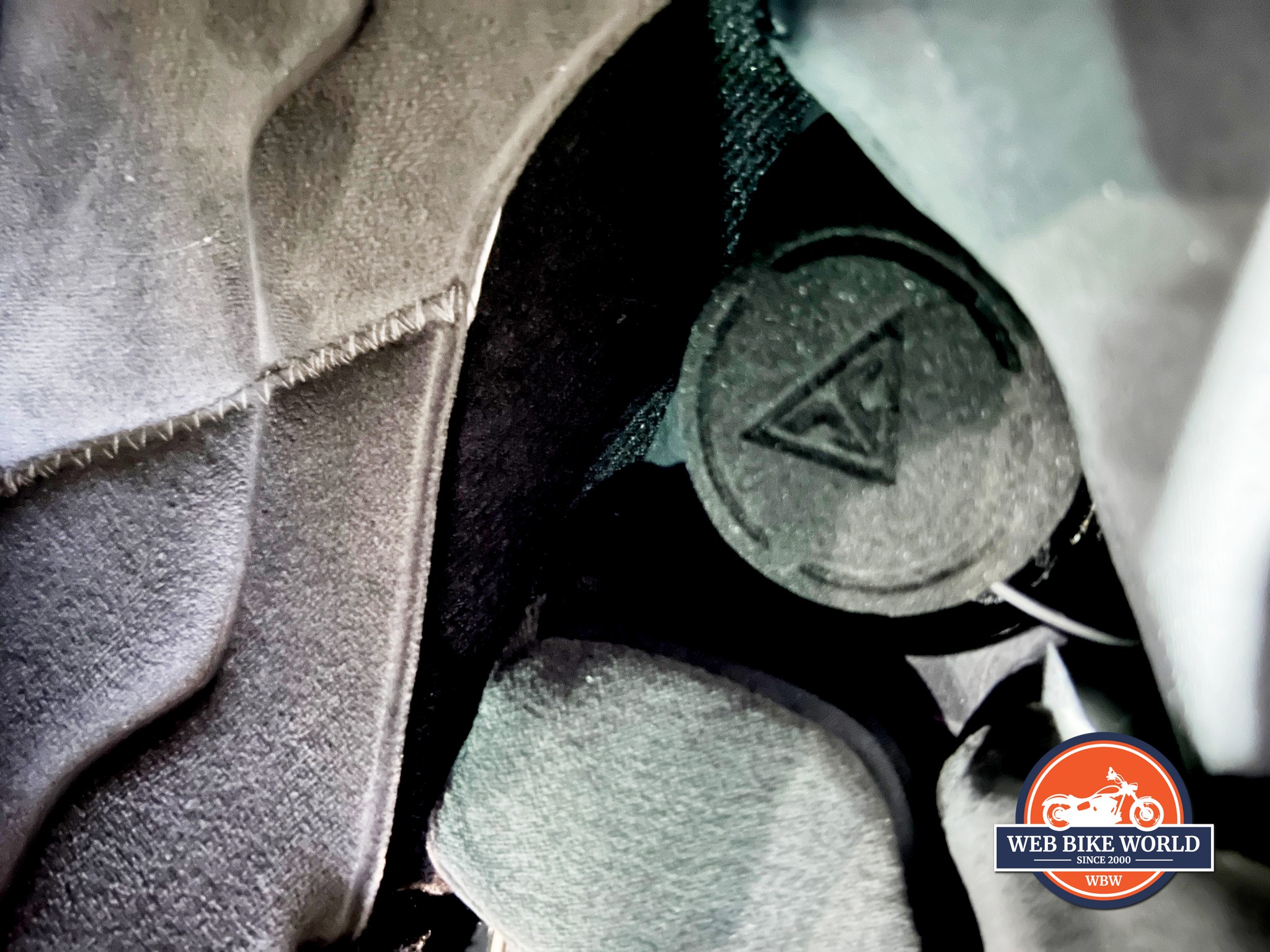
Unlike the MK1 speakers which were glued in place too far away from my ears, the MK1S speakers can (should) be shimmed before your first ride using the velcro pads provided in the box with the helmet.
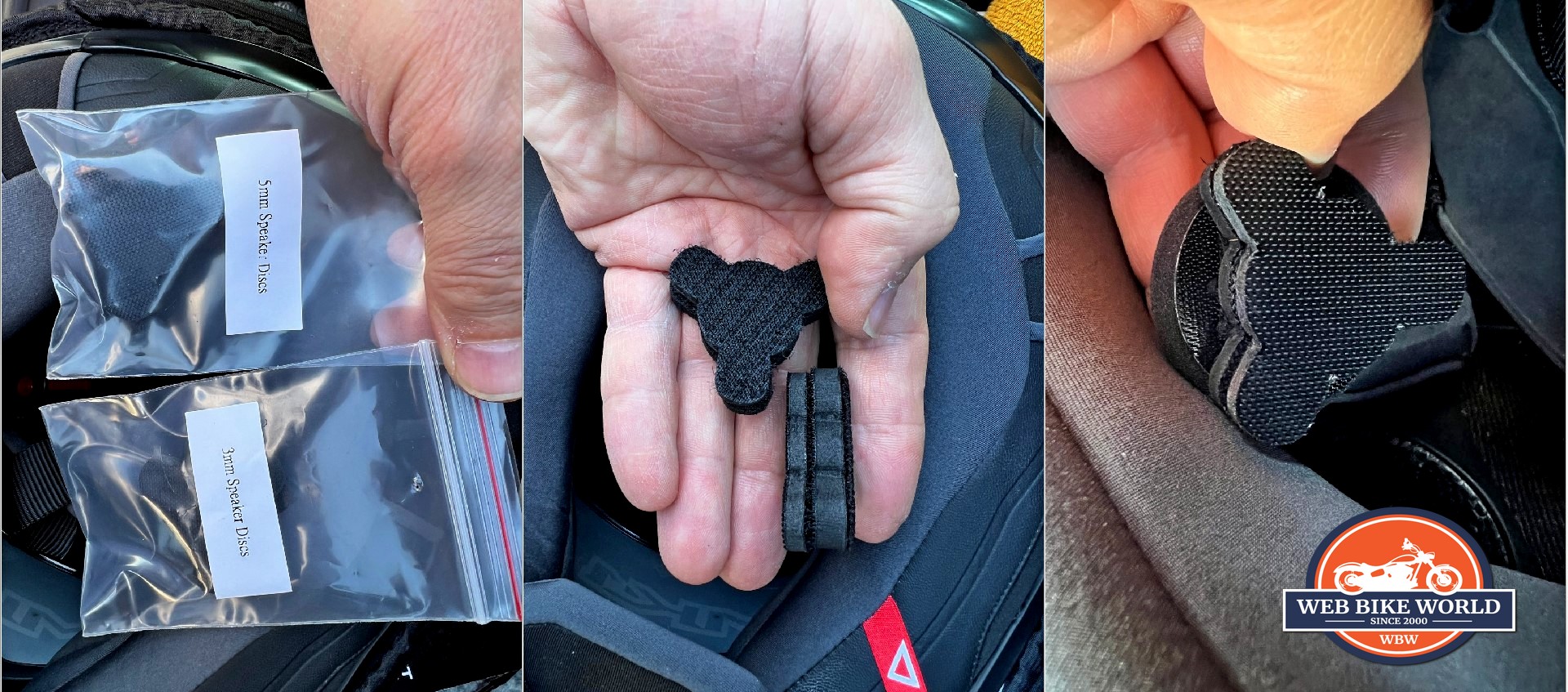
When Dylan handed me my test sample MK1S he warned me to use all the shims included in the MK1S kit equally on either side to get the speakers positioned correctly and he was 100% correct about that.
No complaints from me whatsoever about the speakers. They’re equal to or better than anything else I’ve tested.
Navigation Using the LED Display and the Forcite App
It’s possible to use Google Maps or other navigation apps to verbally communicate directions with the MK1S but it won’t register with the super cool directional and warning LEDs on the HUD if you use anything other than the Forcite app.
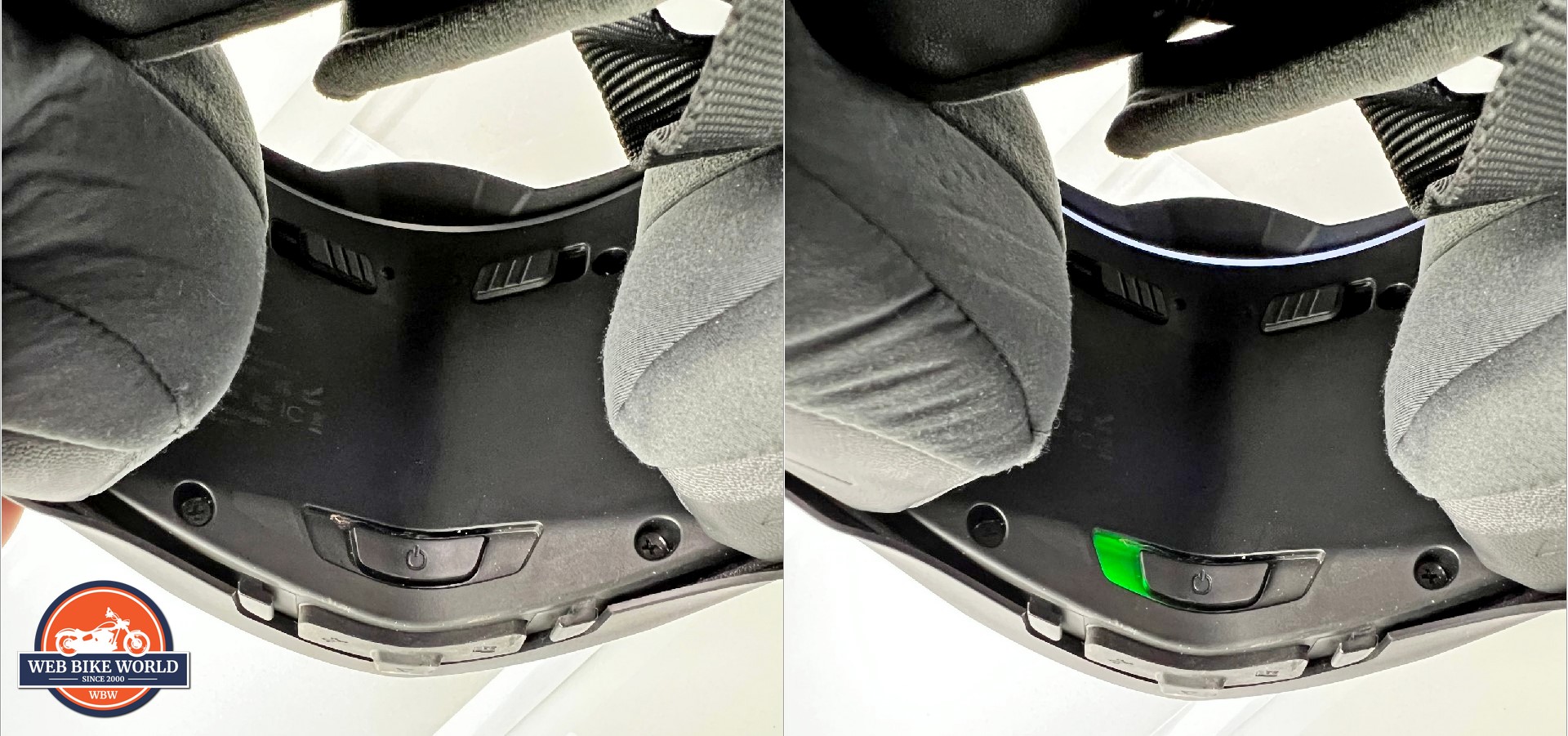
The Forcite app works very well for navigational needs and additionally, it attempts to warn me about construction, stalled vehicles on the road ahead, and most importantly police speed traps.
If you watched the video at the start of this review and saw the LEDs in action you’ll note that the two outer lights sweep from the center outwards to indicate a left or right turn. In low light or even a cloudy day these pop beautifully and are easy to see– although I think I would prefer they flash like a turn signal does instead of sweeping, but that’s personal preference. Conversely, in bright sunshine, I can barely make out the lights while navigating and instead rely on verbal instructions.
Fortunately, there’s an accompanying audible announcement pumped through the speakers reminding the wearer to turn or continue straight depending on what the planned route requires.
I’ve no complaints about the LED HUD when it comes to navigation.
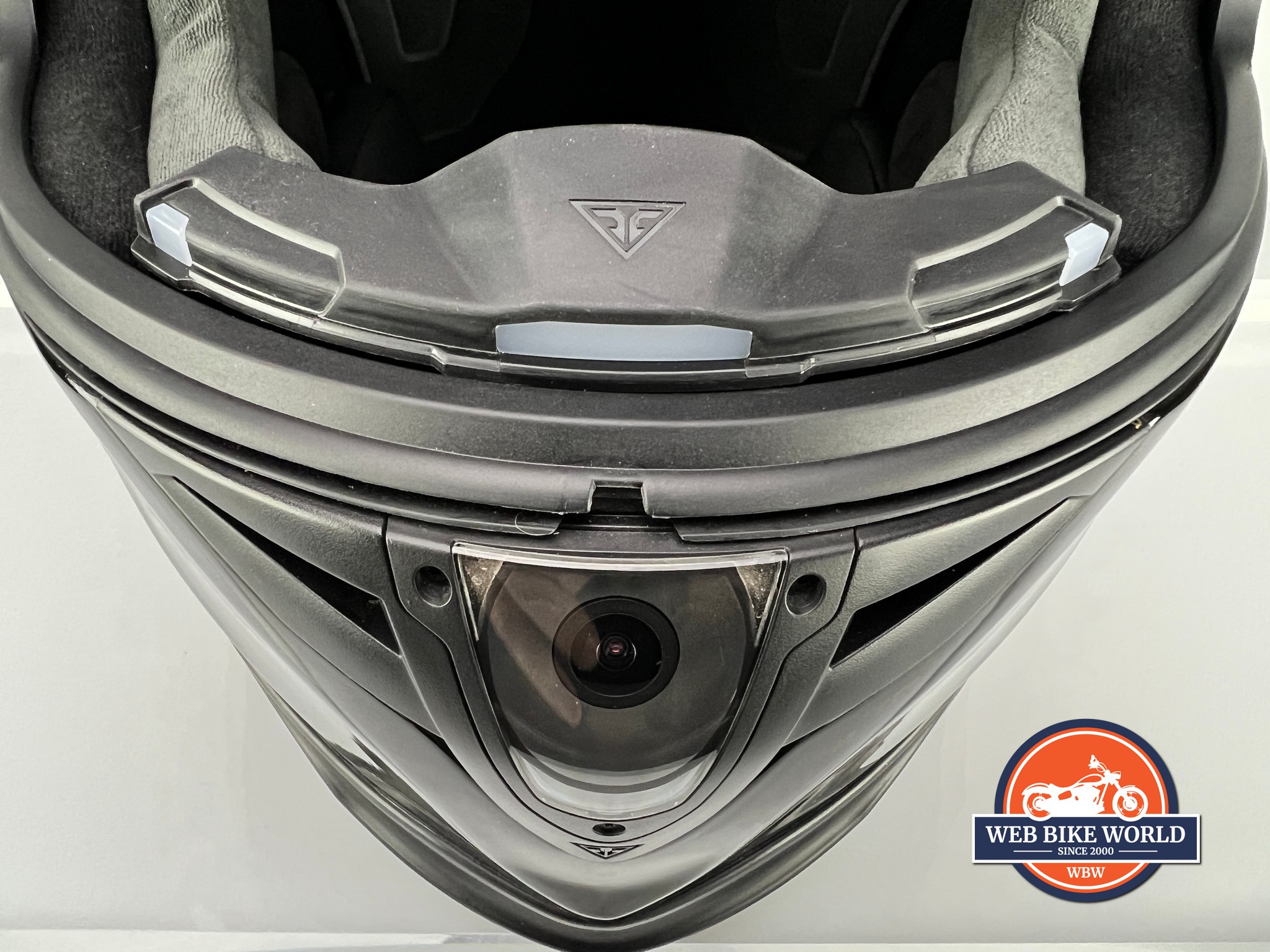
The RAYDAR Alerts
The RAYDAR warning system leaves me unsatisfied due to the lack of consistent accuracy in identifying hazards out on the road.
After my initial ride in Phoenix, I estimated the accuracy to be only 50% which is very low. The system warned me about stalled vehicles that were already gone or long after I already passed them.
Some police speed traps never registered at all with the MK1S while others were reported too late or so early that I would almost forget about them… and yet other times the accuracy was shockingly precise!
Is It Helping or Distracting?
This leads me to conclude there are two ways of looking at this smart technology which follows the wearer’s individual mindset.
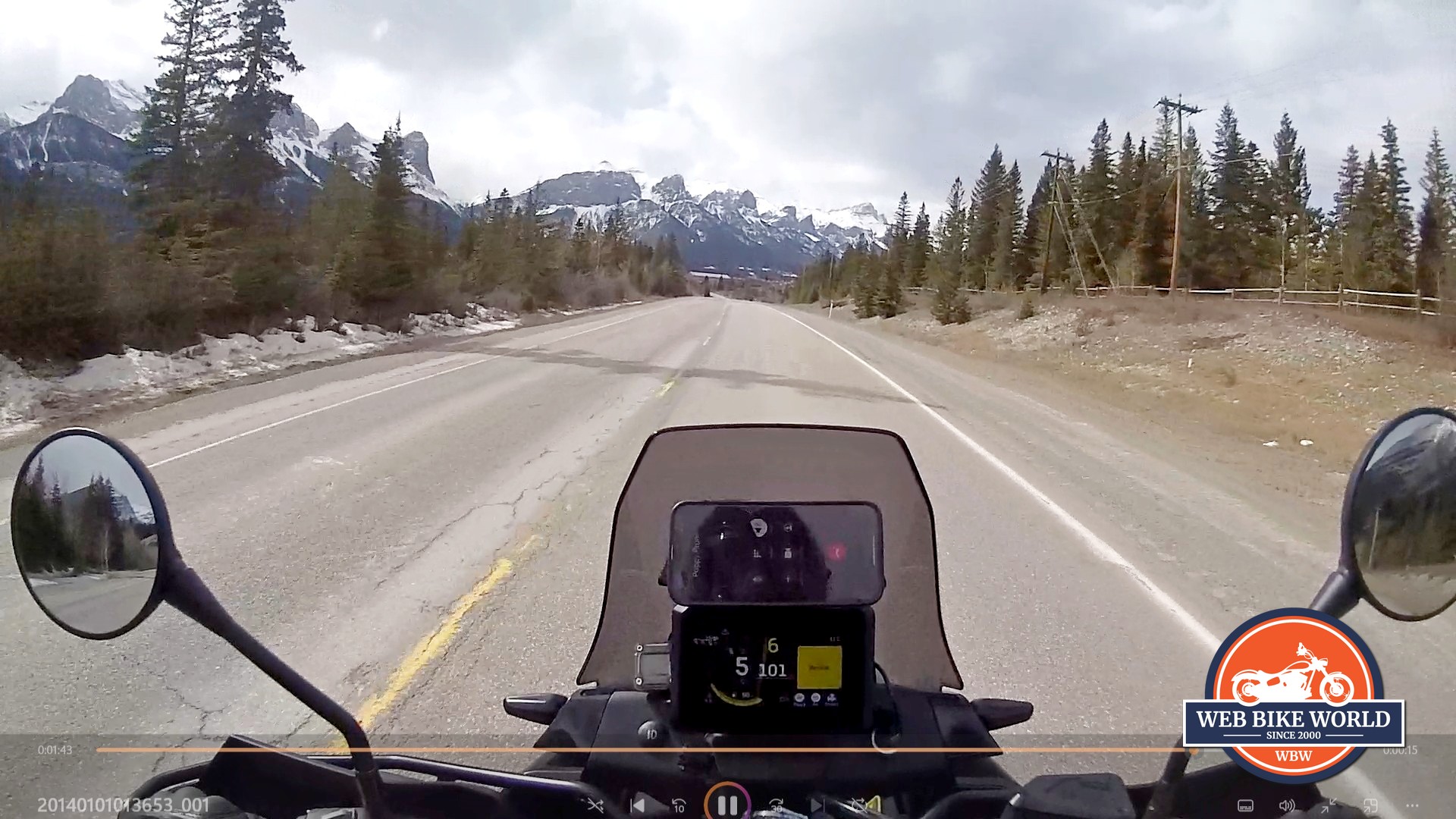
One group of riders will say any amount of assistance offered by the MK1S in avoiding road obstacles has the utmost value even if somewhat imprecise, while the other side will say it’s distracting when the MK1S often “cries wolf”. Does that make it a distraction from actual, real-time threats encountered or help keep the rider at alert level Defcon 1?
For myself, I believe that this tech is super cool, and I love the potential of a warning system to help me. However, with the MK1S specifically I have to stress the need to continue scanning with the same degree of focus as usual (due to the level of inaccuracy) to truly stay safe.
Once in a while, the RAYDAR probably will… (might?) catch something a perceptive motorcyclist wouldn’t, but the current level of inaccuracy dulls its value for me. After several rides focused on determining the accuracy in Canada and the US, I would rate it at best between 60 and 70%. Not bad, but not what I had hoped for. It may score higher or lower in different cities I haven’t ridden in yet because the Forcite app relies on data entered into other apps by people in the area to provide alerts for the MK1S wearer.
Having said that, if it saves me from one or two speeding tickets I might eat my words…
No Bluetooth or MESH Intercom
As impressive as the MK1S tech package is there’s one massive omission in the repertoire of technology: no built-in intercom system.
MK1S wearers still can communicate with other riders or their passengers by simply making a phone call that will channel the audio perfectly to the helmet speakers and use the built-in microphones for speech. Alternatively, the MK1S can use apps like Discord or even the Chain app Ruroc created for their Atlas helmets which have the same lack of built-in intercom systems.
The only problem with that plan comes when cellular service isn’t available or the user has a limited amount of data in their phone plan.
Almost all in-helmet communicators on the market currently have Bluetooth intercom as a feature, so why did Forcite skip this? It’s puzzling.
You Can’t Take It With You
Finally, it’s not possible to take the smart technology module from an MK1S and install it in a non-Forcite helmet once the usable life of the MK1S is reached.
In comparison, with Sena or Cardo devices, it takes only a few minutes to transfer over to your next new brain bucket.
Final Verdict
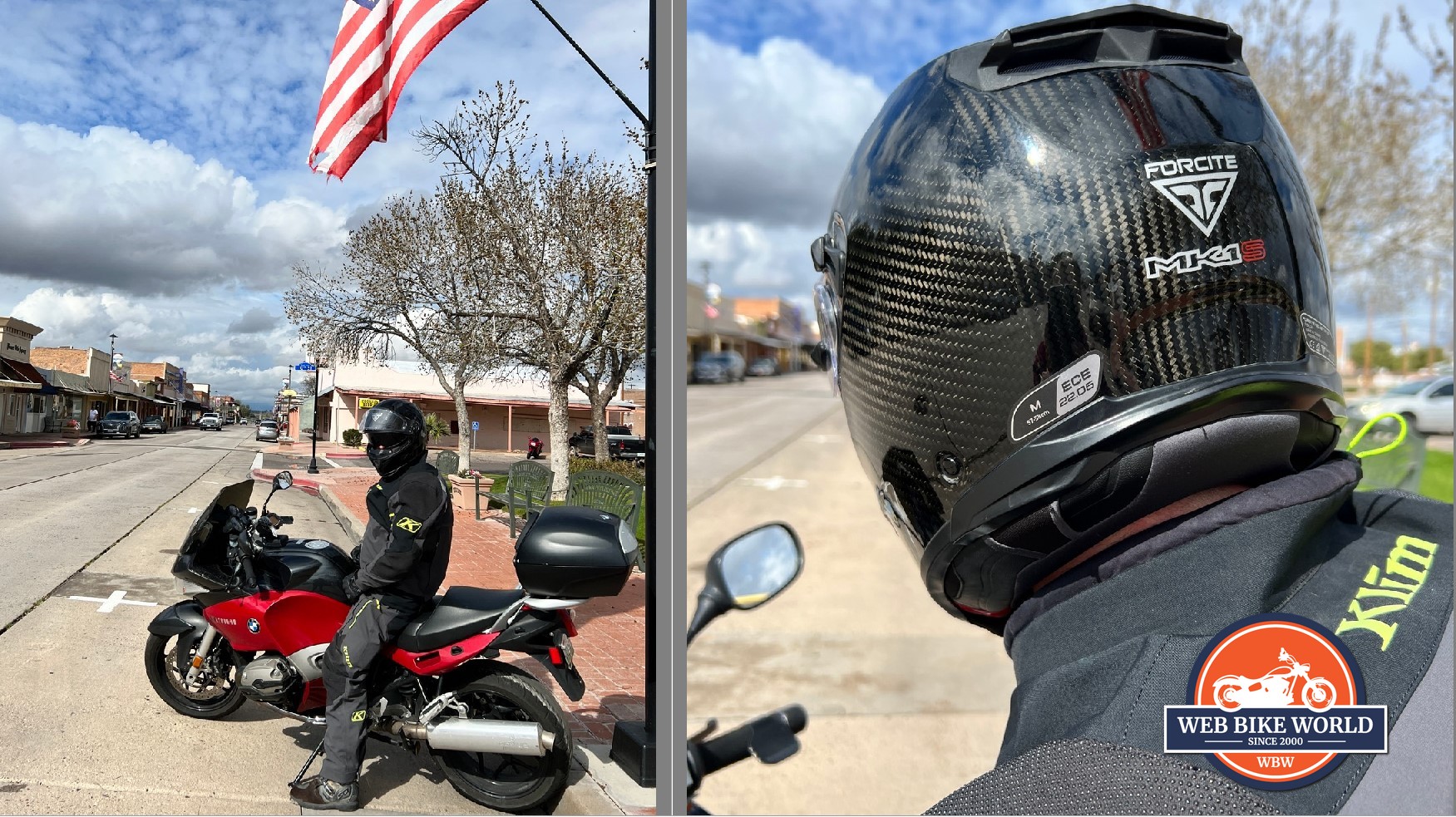
Was I unfairly expecting perfection from the MK1S technological wizardry? Maybe. I’m sure my children will confirm that when I really care about something or someone I can be quite critical but it comes from a desire in me to be constructive, not negative or mean.
It may not seem like it after reading this review, but I really like the MK1S and Forcite as a company. They recently offered to sell Forcite shares to interested investors and I would have put my money in the pool if it wasn’t important to avoid a conflict of interest when I review other helmets for wBW going forward.
The MK1S didn’t perform perfectly for me, but that doesn’t mean every one of them is like this. I’m only sharing my individual experience.
Dollars and Sense
Let me end on a financial note to better help judge the value of this helmet Forcite has successfully built where some failed or others never tried at all. Do famous brands like Shoei, Schuberth, Bell, AGV, Shark, or Arai have smart helmets? No.
Let’s Try To Build an MK1S
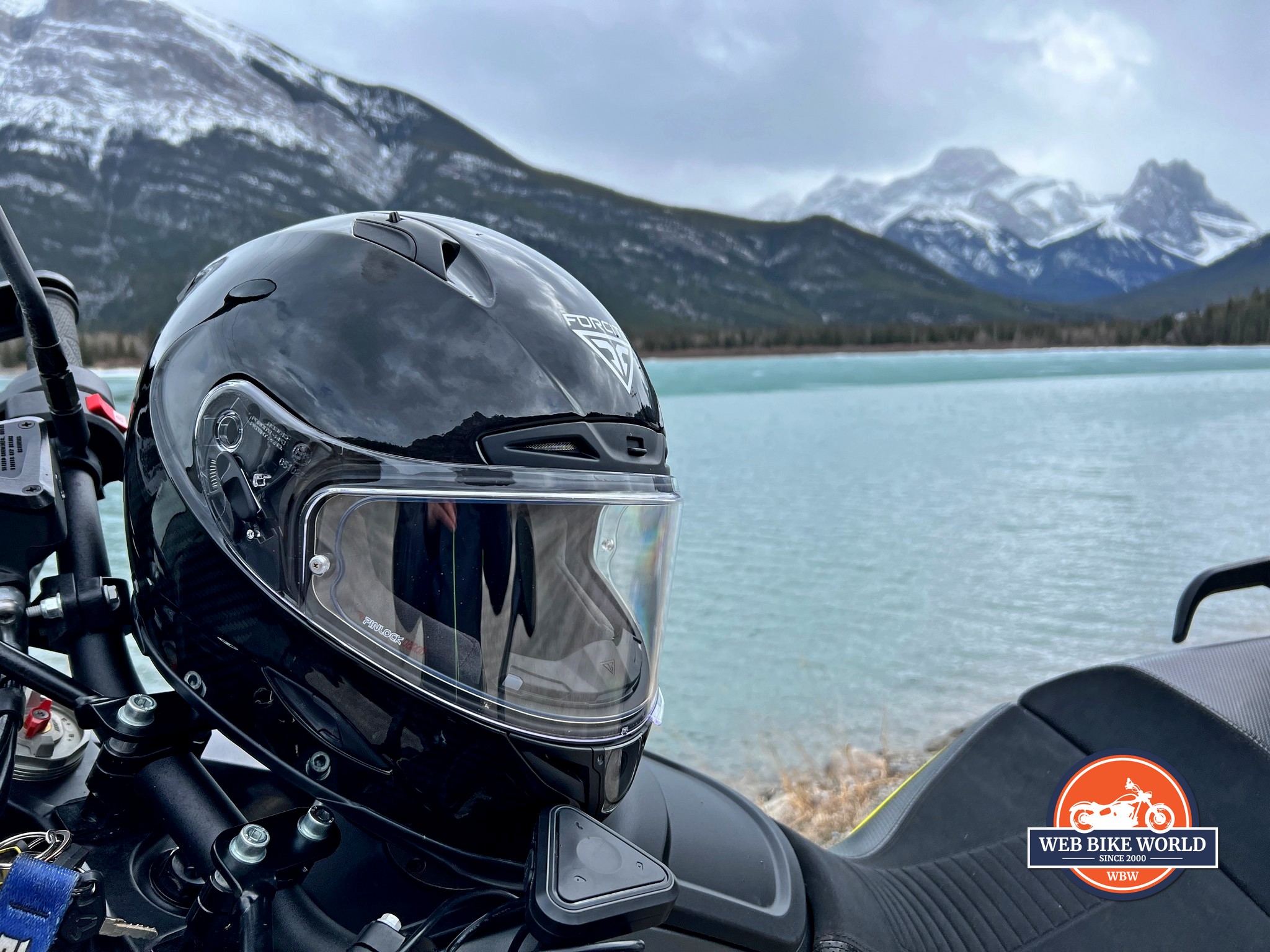
If I were to take existing components from many different manufacturers to build something comparable to the MK1S what would it cost compared to the MK1S’s $1099 price?
I would start with a similar helmet like the Scorpion ST1400 Carbon at $430 (Pinlock included).
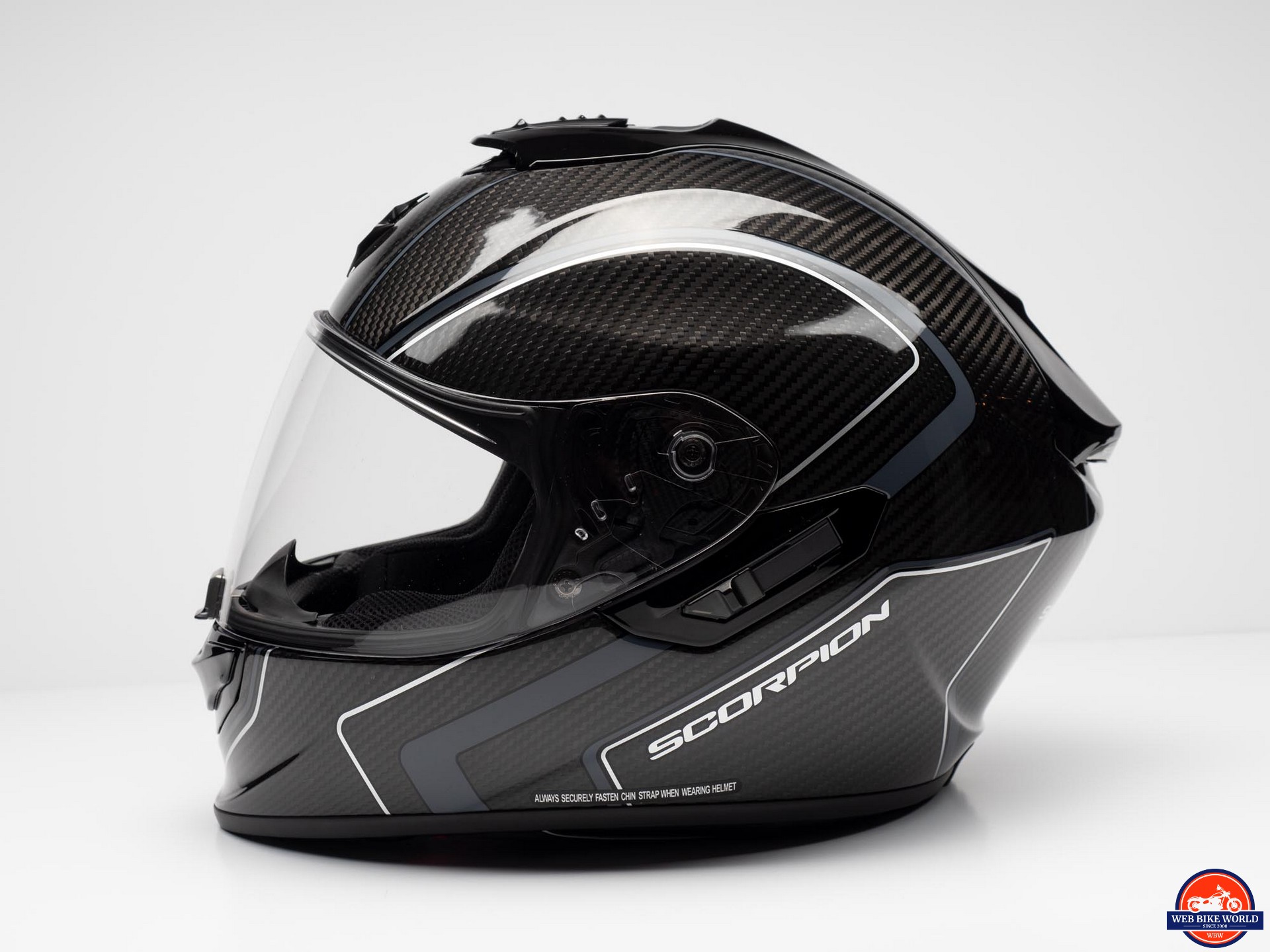
Add a 4-button Sena handlebar controller that would be close to Forcite’s for $100.
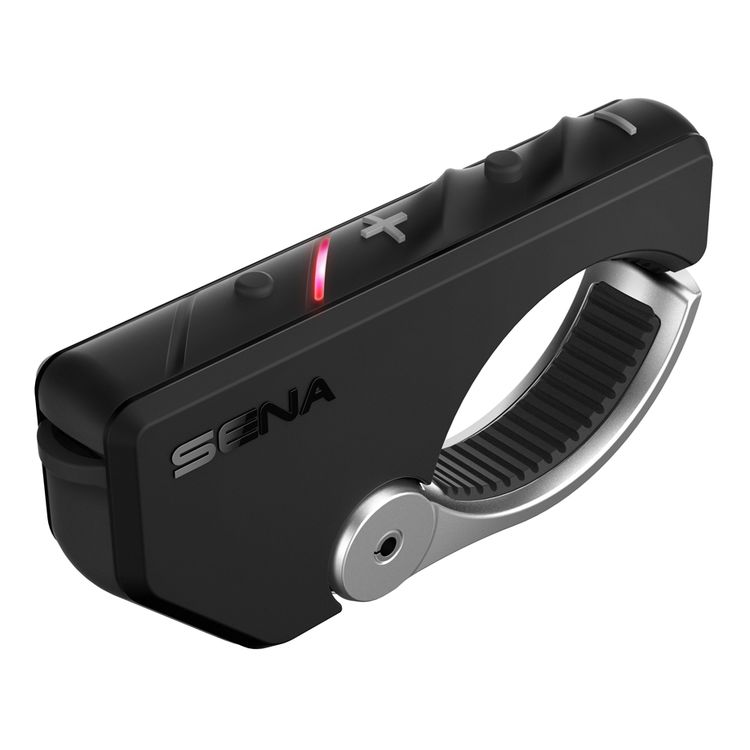
For a comparable but not exact camera, I’d pick the 1080p Sena 10C Pro for $350.
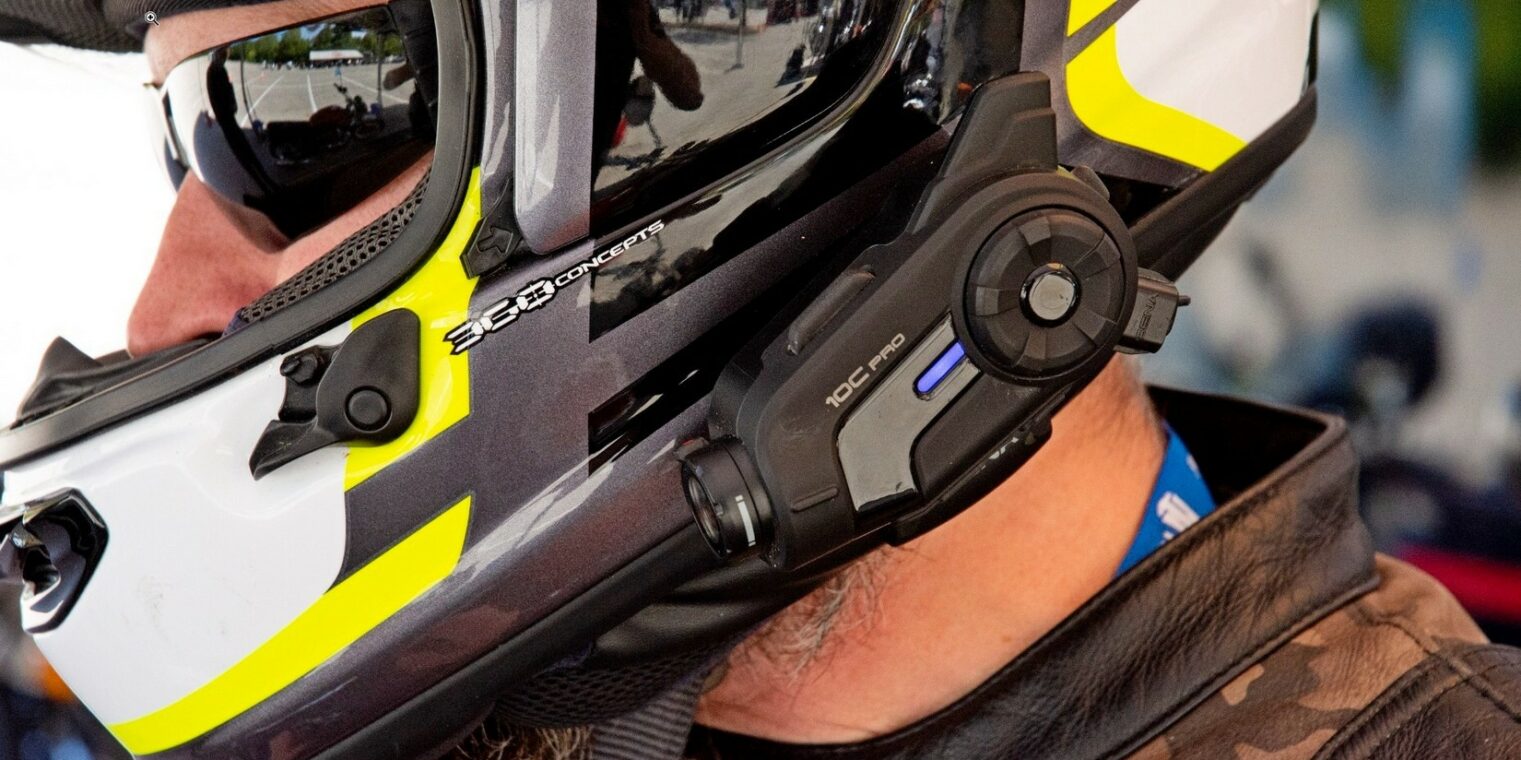
Harman Kardon speakers would be the ones Sena sells as an upgrade for $69.
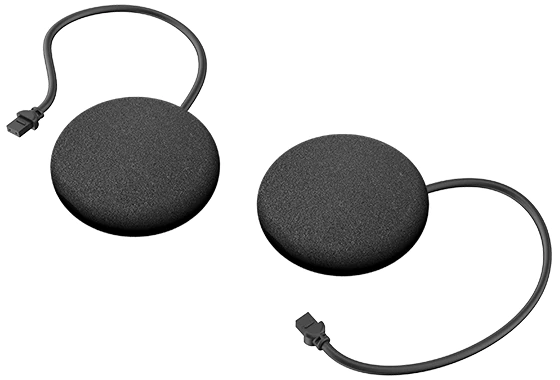
I’m at $949 US at this point but I can’t find anything to mimic or replicate the RAYDAR and LED HUD. My guess is the MK1S tech module would cost more than $150 if it sold as a separate product on the market today.
It seems fair to say the MK1S is priced reasonably even though building something similar for about $150 less would mean exchanging the LED HUD/RAYDAR for the benefit of the Bluetooth intercom featured on the Sena 10C Pro.
But There’s More…
Upgrade to a Sena 10C EVO for $100 above the 10C Pro price and you get Bluetooth intercom and 4K video quality along with longer battery life.
Pay $200 above the Sena 10C Pro and add the Sena 50C which will include the $69 Harman Kardon speakers (making it only a $131 increase actually), 4K video or 1080p @ 60fps with image stabilization, improved battery life again, and MESH intercom. The 50C is a large, bulky thing to have on the side of your helmet though.
Another plus for building your own: you can move all this hardware to your next helmet if it’s still in working order after 5 years.
But, you still won’t have all of it perfectly integrated into the helmet as with the MK1S or the sophisticated LED heads-up display with the RAYDAR system helping protect you in a “Frankenstein-smart” helmet.
What’s most important to you? Having a well-built helmet with smart tech attached to it or having a well-built Smart Helmet?
- Jim
Pros
- Lightweight, good quality build, fully integrated high tech electronics, provide enhanced safety.
- It’s easy to download video from the helmet using a mobile phone or PC
- The visor and helmet didn’t leak even when used in heavy rain riding
- User-friendly setup guide built into the app.
- Navigation works really well with the LED interface in the chin bar
- Decent video quality (1080p @ 60fps)
- Handlebar controller, Pinlock 120, two charging cables, Harman Kardon speakers included
- Excellent speaker sound and placement in the pockets (after shimming)
- The drop-down internal sun visor is tinted darker than average and has great coverage
- Adequate airflow/ventilation
- A good fit for round oval-shaped heads
- Racing-approved helmet outside North America that can record exciting video footage “from the cockpit”
- Good battery life and can be charged while in use, 256G memory card compatible,
- The electronics module mounted in the chin bar might provide enhanced crash protection
- Good customer service and generous replacement plan available after crashes
Cons
- No image stabilization on video, competitors often have 4K video, audio quality on recorded video is affected by wind noise, and insufficient audio pickup by dual microphones
- Chin bar vent switches located on the inside of the helmet
- LED lights on the chin bar interface aren’t as easy to see in bright sunlight
- Somewhat noisy at highway speeds
- Will DOT-only certification be acceptable on North American racetracks?
- The abrasive mesh material on the front of the crown liner chafes my forehead
- The chinstrap snap is difficult to use with gloved hands
- Forcite app navigation map won’t rotate horizontally to mirror the phone position
- The RAYDAR system could be more accurate
- No Bluetooth or Mesh communication system, users have to use phone data or phone calls to talk to friends/passengers
- Some glitches remain in the tech to work around, and my handlebar controller malfunctioned
- The shape of this helmet might be uncomfortable for longer and narrower shaped heads
- iPhone users need to purchase a $40 US adapter to download video to their phone, and no memory cards are included with the helmet
Specs
- Manufacturer: Gao Jin Industrial (ZEUS Helmets)
- Price when tested: $1099 to $1200 US plus an additional $40 for iPhone owners
- Made in: Shell is manufactured in Vietnam and the electronics module is manufactured in Taiwan Final assembly in Australia.
- Sizes: (XS) 53cm – 54cm (S) 55cm – 56cm (M) 57cm – 58cm (L) 59cm – 60cm (XL) 61cm
- Colors: Matte or Gloss Carbon Fiber and Nexus by Drudi Performance
- Safety Designations: ECE 22-05 and DOT FMVSS 218 (ECE 22-06 coming December 2023?)
- Review Date: April 30
Important Links
- Where to Buy: Forcite approved dealers only


